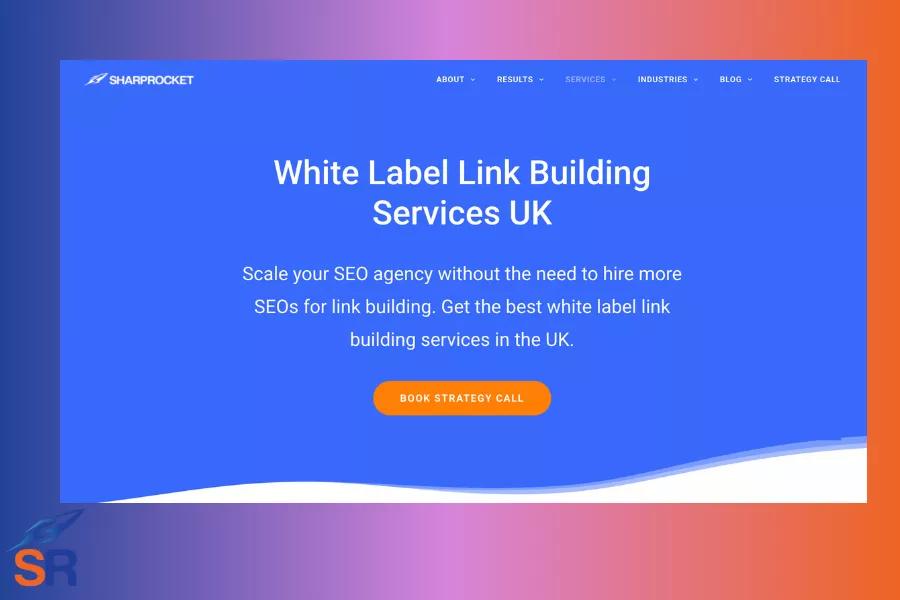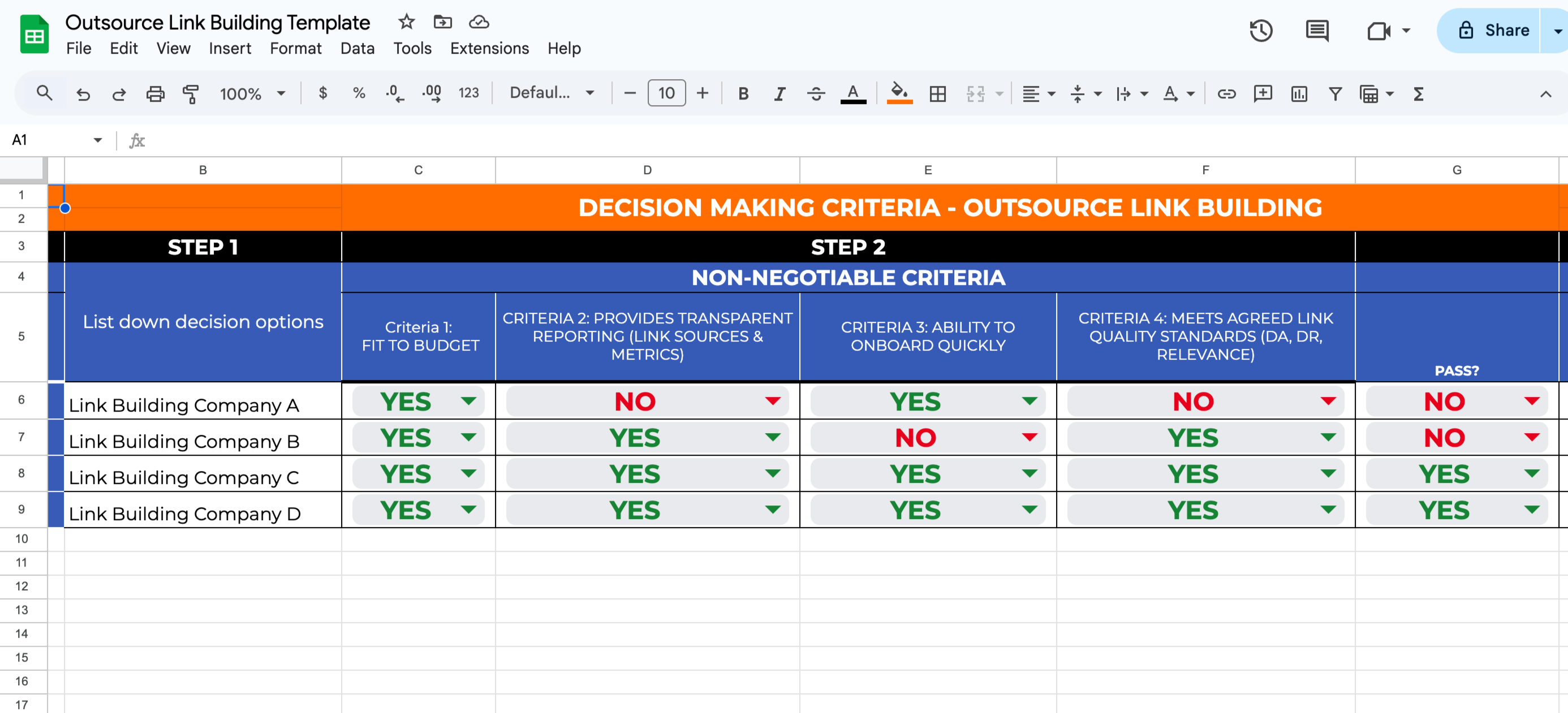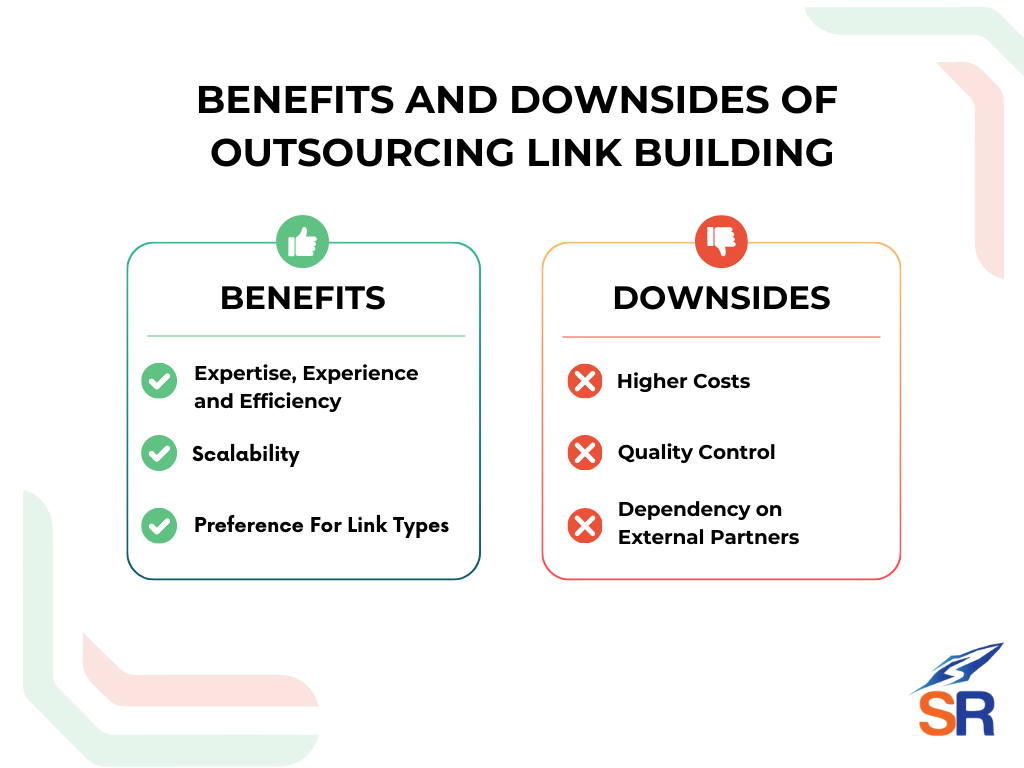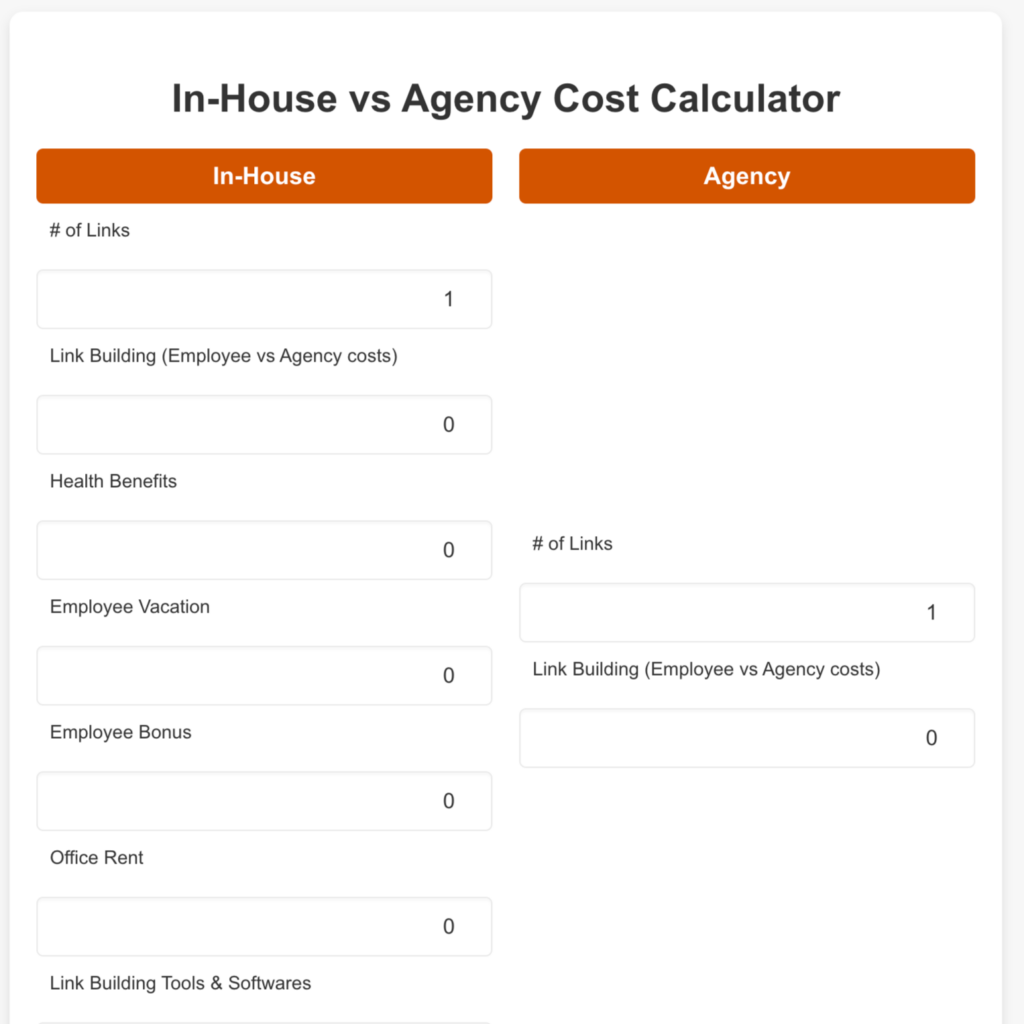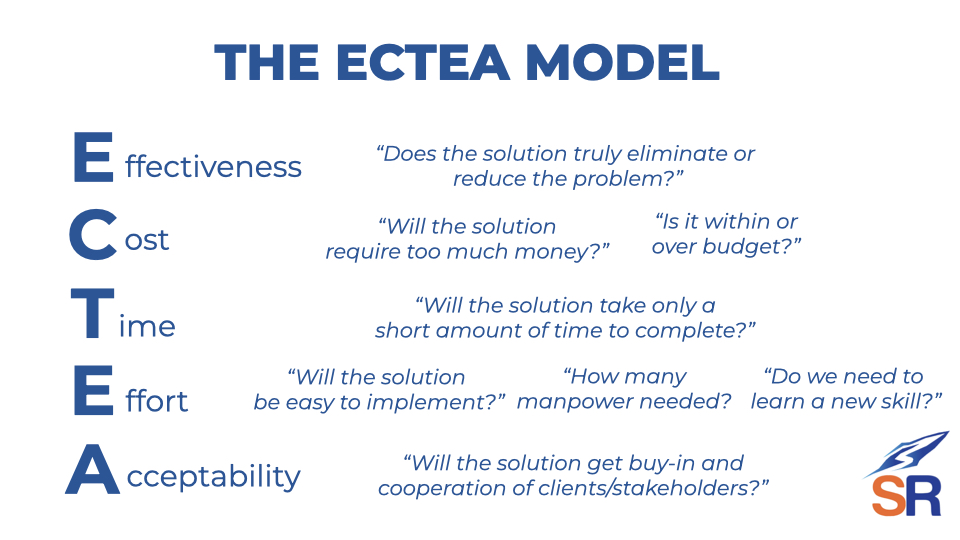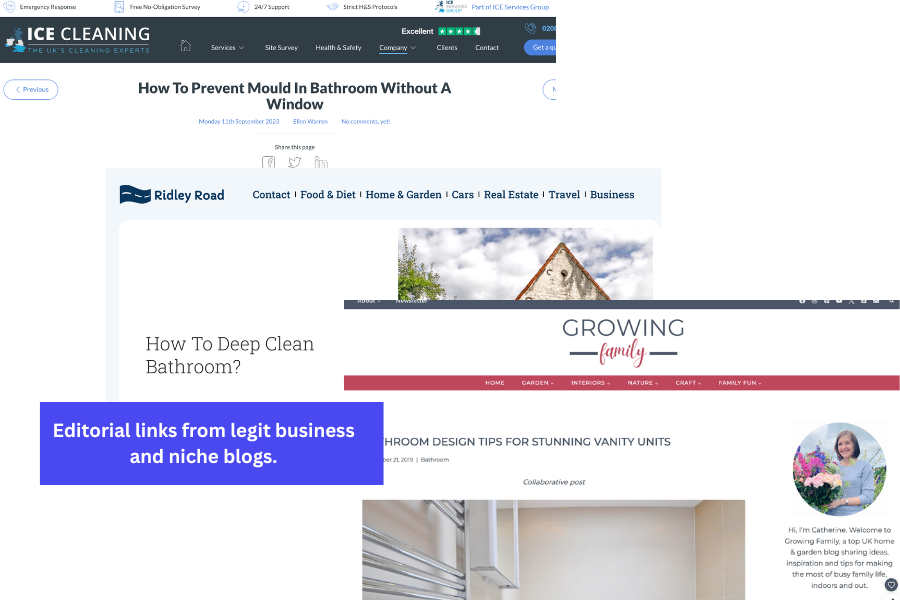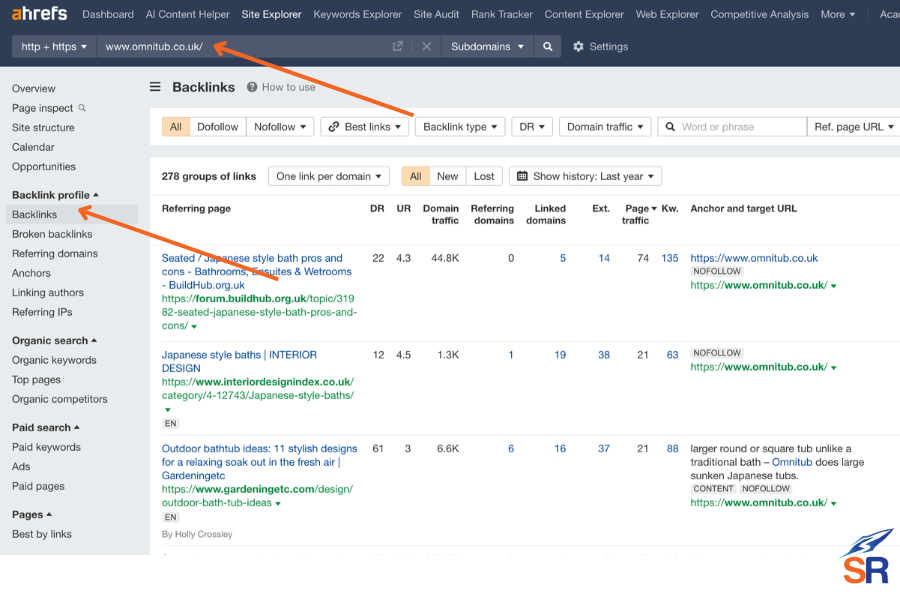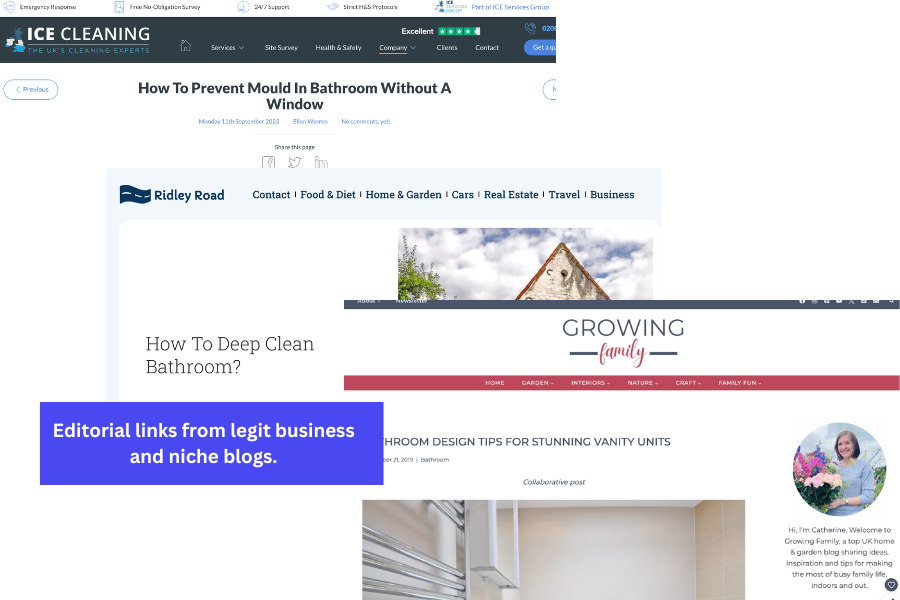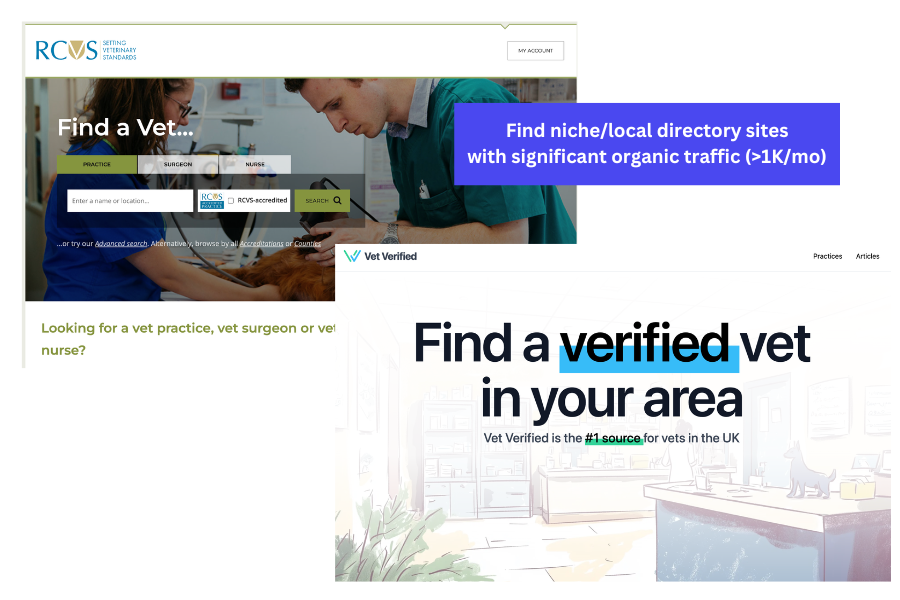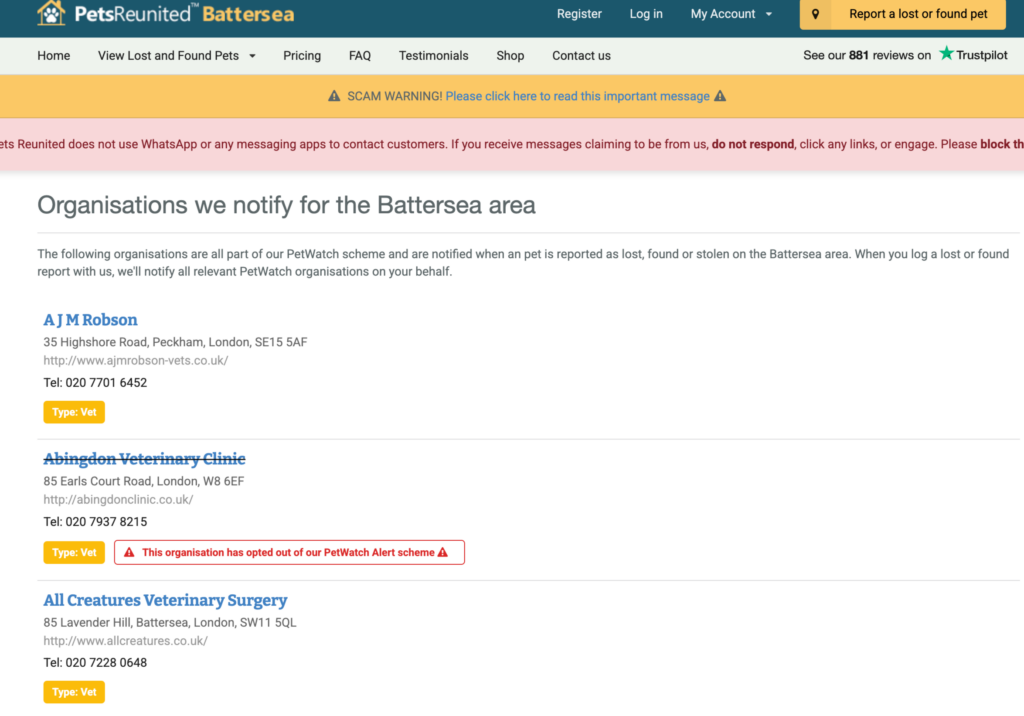HARO Link Building: Strategies and Systems That Actually Work
HARO link building has been a standard practice for many digital PR and SEO specialists in getting contextual links from trusted and authoritative niche publications and news sites.
I've watched this median platform - HARO, from being one of the early entries in the digital PR realm, to now being a go-to platform for agencies and in-house marketers, even more established after being bought by Featured (another digital PR platform focused on expert commentaries/inputs).
Here are a couple of benefits when using HARO as an effective branding tool:
- Automates the entire process of finding expert input requests relevant to your industry (which would take you a couple of hours doing it otherwise - manually prospecting using X, using better Google advanced operators, and other time-labor digital PR prospecting efforts.
- Builds thought leadership of clients' personas or in-house personalities, which translates to better brand recognition and authority as they represent through their expertise and actual experience.
- Increases the link gap between your site and your competitors through the quality of backlinks you'll acquire from expert commentaries, as these links aren't easy to replicate by other methods, such as link insertion, guest posting, etc.
- Strengthens your site's backlink profile, helping your brand compete for more competitive keywords that require a significant volume of links to appear at the top of Google's SERPs.
- Flows more trust to your site and could help AI further see your brand as an authority figure in your niche, through an author or expert.
How to Use HARO for Scalable Link Building
Start by signing up on HARO to receive emails listing their daily HARO queries sent twice daily (Afternoon and Evening editions).

From here, the success of HARO link building campaigns lies in how you set up processes to scale your efforts and resources (which mainly comprise your time and thinking through every answer for a given query).
While it may seem ideal to respond to every HARO pitch, you only get a few quality opportunities per industry - so every detail of the pitch is worth optimizing for.
Here are techniques we've been tested to work in scaling HARO link building campaigns - for in-house enterprise marketers and SEO agencies:
Maintain HARO Inbox Hygiene
Setting up a HARO account is simple, but the real work happens when you organize all emails. Without a system, your inbox quickly becomes a flood of mixed queries, making it harder to spot high-value media opportunities.
Filtering, labeling, and sorting - as I call it "inbox hygiene" is critical to streamlining the entire workflow of answering queries - prioritizing relevant and urgent ones and responding faster before the deadline closes.
Here are essential Gmail setup tips for HARO link building:
- Create a dedicated Gmail account for HARO responses to instantly have a focused email and avoid cluttering it with personal or team emails (which are often more time-consuming and eye-overwhelming than actually responding to HARO queries).
- Add a second Gmail if needed, especially if you're handling multiple clients or in-house personas - best to use Google Workspace for agencies.
- Create a professional signature that includes your name, position, company, and a direct link to your website or LinkedIn - this is HARO 101.
- Manage multiple Gmail accounts using Chrome profiles to switch easily (only applicable if you set up several HARO link building accounts)
After setting up your emails dedicated to HARO link building, the next inbox to-do is creating a filtering system.
Here are our inbox filters and efficiency tips:
- Use color-coded labels in Gmail to visually prioritize fast-turnaround opportunities - ultimately helping when juggling multiple Gmail accounts.
- Archive old queries after 48-72 hours to keep your inbox clean.
- Star urgent queries based on relevance, publication familiarity, or specific preferences.
Analyze HARO Queries
One of the biggest mistakes some digital PR and SEO specialists make is the lack of criteria when responding to HARO inquiries. Many treat every query the same, as long as it is topically relevant to their niche - by default, they think it's worth a good shot for pitching.
But HARO link building goes beyond just niche relevance - it works differently as it relies heavily on the input, the person giving the input (expert), and his/her current background (experience and expertise).
When starting any HARO link-building campaign, check the HARO query to see if it aligns well with the correspondent's expertise, your ability to present and position expertise, and the person's relevance.
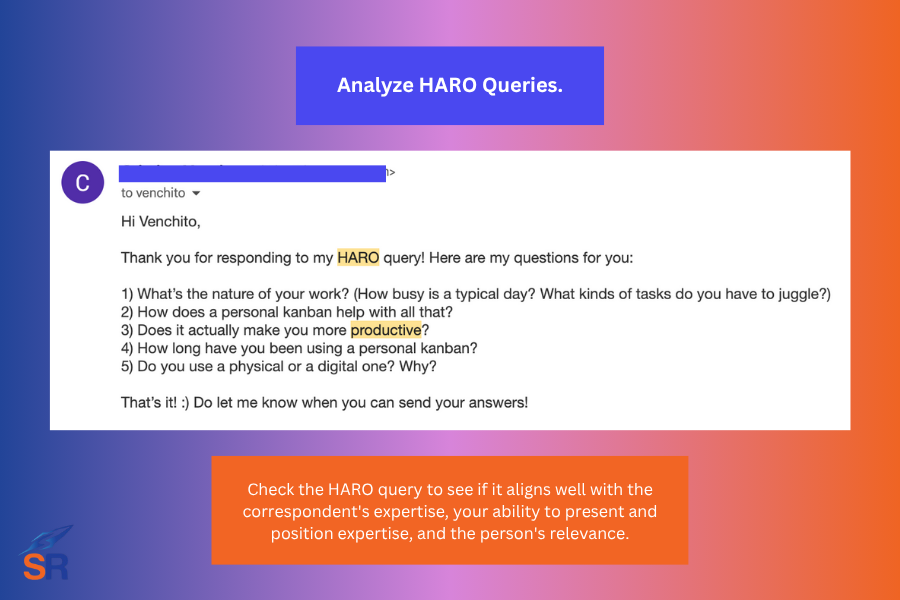
Given that you don't need to be all-knowing in every realm within a subject matter, but just credible enough to provide insights based on your experience and expertise.
This is where you also need to determine the validity of the opportunity. If a HARO query is too urgent and highly relevant to your expertise, it should be at the top of your list when responding to relevant queries.
Leverage Expert Positioning
Expert positioning is a big part of HARO link building campaigns. It means knowing how to present yourself as the right source for a specific query.
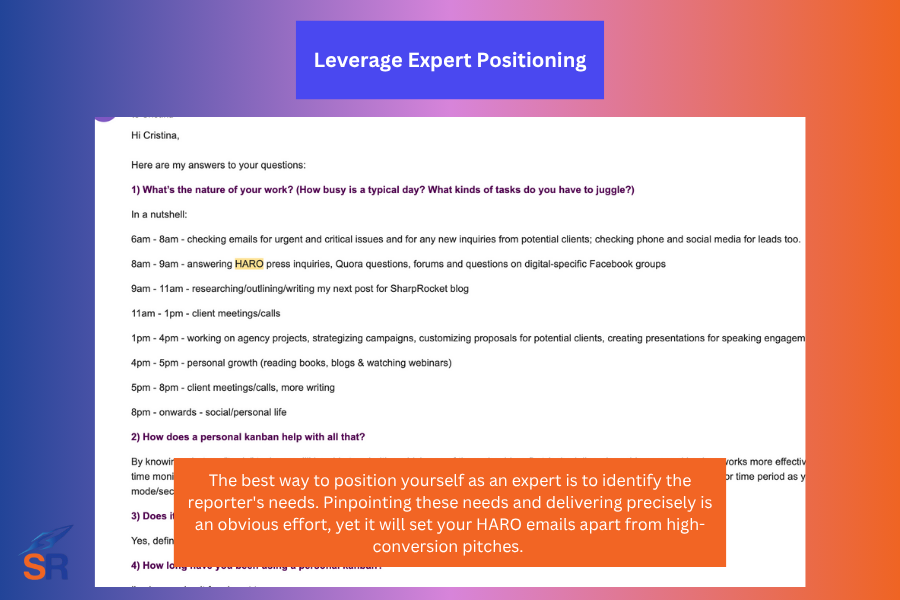
By establishing expertise immediately in your pitches, you can instantly capture the interest of your target journalists or reporters, making it easier for them to consider your inputs.
The best way to position yourself as an expert is to identify the reporter's needs. Pinpointing these needs and delivering precisely is an obvious effort, yet it will set your HARO emails apart from high-conversion pitches.
Start expert positioning by reading the entire pitch request requirements and assessing the inputs they are looking for. Are they looking for trend insight, a technical explanation, or a personal experience? With these specifics in mind, you can adjust your HARO pitch template later on, which would significantly dictate the conversion rate of your campaign.
Here are a couple more tips if you want to integrate more expert positioning in your HARO response pitches.
- Anchor your introduction to the expert's actual role (i.e., "I'm the founder of X coffee brand sourcing directly from local farmers", instead of a vague response like "I run a business").
- Match the tone and depth of the query. For instance, a personal finance query needs precise numbers or strategy, while a lifestyle topic needs more relatable, first-hand experience.
- Avoid overusing accolades, media mentions, or awards, especially if they are unnecessary to the query. Always keep the pitch aligned with the topic.
- Attribute the input to a real, trusted source (yourself or your client) using actual experience, not recycled insights.
The key to succeeding in HARO link building is figuring out the breadth and depth of your/your client's expertise early—the wider the scope of knowledge you can provide input for, the more HARO queries you can respond to.
Create Expert-Role Email Templates
Many digital PR and SEO specialists believe templates no longer work. They only dilute pitch quality by being too structured and are often flagged as spammy in someone else's inbox.
In our decade of doing link building outreach and digital PR campaigns, we can guarantee that it's almost impossible to scale link outreach without templates. For HARO, a huge part of the outreach campaign comes down to how easily it is to hyper-personalize pitches with less friction using outreach templates.
Unlike other outreach-driven link building campaigns, such as guest blogging, link insertions, and blogger outreach, there are only a few placeholders in outreach email templates for inputs, so you can effectively send semi-personalized emails to hundreds or thousands of link prospects. HARO pitching requires high customization to turn a HARO query into a link placement.
Create a standard email template for each role, correspondent, or thought leader you represent. If you're working on three digital PR campaigns, you need three separate email templates for each campaign.
Each correspondent represents the expert—you or your client, whom you'll pitch in on behalf of.
For instance, if you're corresponding with a coffee machine retailer, you aim to speak on behalf of your client as someone knowledgeable and experienced in the coffee industry. When you filter HARO emails, you will only be looking for expert input requests about brewing methods, machine quality, or maintenance tips.
Use Language That Gets Quoted
Framing your insight like a ready-to-publish quote is one effective way to make your pitch stand out among the hundreds, if not thousands, of emails journalists receive daily. It helps journalists save time sifting through the correct information they need from experts.
The best way to start is by placing the value at the top of the email. After establishing your expert positioning, give the exact "expert input" they request in their HARO queries.
A couple of things that will make your writing more enticing for journalists:
- Use concise, vivid phrasing that sticks.
- Sprinkle in lyrical elements when appropriate - adds flavor and brings your voice as an expert.
- Keep it natural - don't make pitches impressive, but instead must reflect your confidence and personality.
- Prepare 2-3 go-to phrases you can reuse, giving your pitches a recognizable edge. Just make sure you tweak them as needed.
- Run your pitch through Grammarly - clear writing builds credibility.
Turn Nofollow to Dofollow, Unlinked to Linked
Providing the right expert input takes a lot of work, so it's vital to ensure that you get the most benefit from your efforts while adding value to journalists.
Track new mentions and links using Ahrefs Alerts, similar link intelligence tools, or Google Alerts. Set alerts to notify you of any new backlinks to your site.
If any links are no-follow, you can reach out to the journalist or reporter and politely request link adjustments:
- For nofollow - ask if they'd consider changing it to dofollow.
- For unlinked - thank them first for using your expert insight, and ask if they could link to your website.
By turning soft wins into real backlinks, you maximize the value of every pitch investment in your HARO link-building campaign.
Do Followups
There are a couple of studies that already show that doing follow-ups helps secure backlinks:
- Sending follow-ups increases the number of backlinks by 40% (Source: Authority Hacker).
- Incorporating at least one follow-up email will achieve a 27% reply rate, compared to a 16% reply to those without follow-ups (Source: Woodpecker).
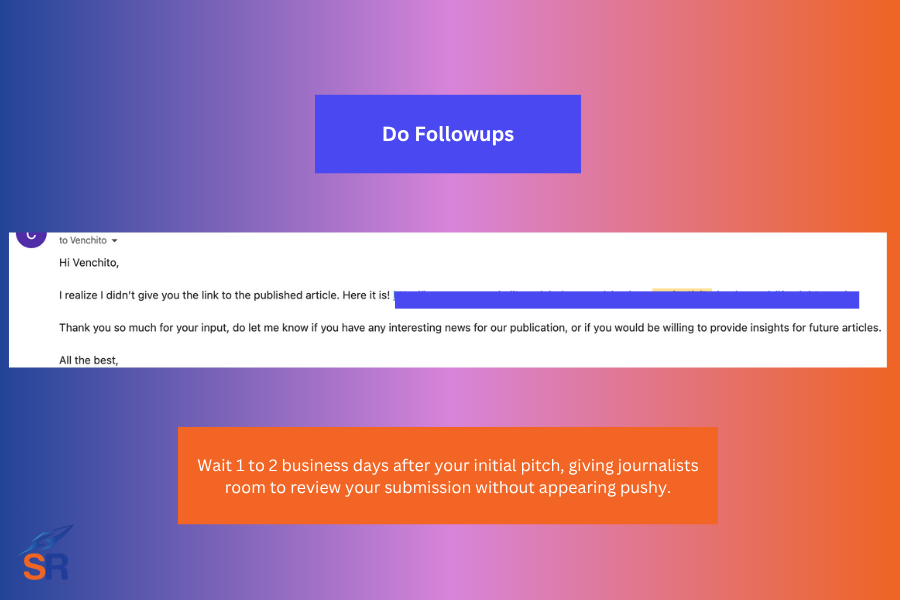
Here's how to do follow-ups effectively:
- Wait 1 to 2 business days after your initial pitch, giving journalists room to review your submission without appearing pushy.
- Keep your message short and polite.
- Include your original quote or reply for context.
- Track follow-ups using a spreadsheet.
- Know when to stop.
Need help running high-impact digital PR campaigns or scaling link acquisition with expert-driven outreach? Explore our link building and digital PR services.
Link Velocity in SEO: How Fast Is Too Fast When Building Backlinks?
Backlinks are still undeniably the strongest signals in ranking websites these days- as links no longer just count as votes of confidence, but also as contextual signals that support entity recognition, citation, and even AI-driven indexing.
In an attempt to outcompete big brands in many industries, most SEO specialists would try to influence their website rankings by aggressively building links at an unnatural pace that doesn't match the site's authority or age, which is not only questionable but highly vulnerable to algorithmic devaluation or manual penalties.
This is where understanding the concept of link velocity comes in—learning why it matters and how to manage it so that it works for you, not against you.
What is Link Velocity?
Link velocity is the speed at which a website gains new backlinks over a specific period (daily, weekly, or monthly), giving data on how fast a site's backlink profile is growing.
How fast should you be building backlinks?
You should build backlinks at a natural pace that aligns with your site's authority, age, and content publishing frequency. For new websites, 5 to 10 high-quality backlinks per month is a safe range. Older, more established sites can earn links, especially if supported by fresh content, linkable assets, and a strong brand reputation.
The Myth of “Faster Is Better”
Getting backlinks at an unusual rate ("fast" but careless) without actual context and control can signal attempts to manipulate rankings.
Here are some scenarios where faster link building becomes a problem, especially when no real-world context justifies the upward trend or spike.
Getting Irrelevant and Types of Links That Don't Matter Anymore
Topical relevance is a strong indicator of a link's value. In contrast, acquiring irrelevant links from websites of weaker domain authority can dilute your site's trust profile and confuse search engines about your site's content theme.
Below are the types of links that are considered to be devalued:
- PBNs, especially multi-category blogs without niche relevance (and which are linking to each other).
- Hacked links - inserted random links into other sites' existing content.
- Forum and comment spam links - irrelevant/spam links in forums as part of signatures
- Low-quality directories - scalable submission of profiles to spammy directories
- Irrelevant link exchanges - doing a link exchange from a completely unrelated website
Off-topic and uncontextual backlinks from irrelevant sources add noise to your site's backlink profile and weaken its branding and reputation.
Unusual Anchor Text Variations
An interesting study by Cyrus Shepard shows that actual text variations in links correlate well with search traffic and that sites with more anchor text variety get better search performance. Conversely, sites with unvaried anchor text links tend to lose search traffic.
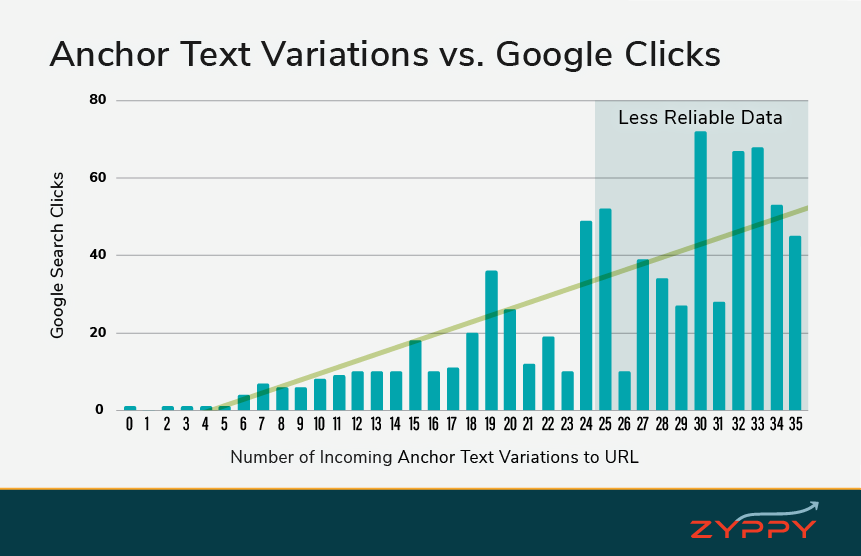
At one extreme end of the pendulum, savvy SEOs are trying to game the link building system with high variations of anchor texts. While this approach is strategic and with a positive intent to naturalize their sites' backlink profiles, it could spell trouble if the majority of the links are filled with partial, and exact match anchors.
In addition, when links are acquired at unnatural link velocity with over-manipulated anchor texts, search engines may be signaled of any manipulation. The unusual link spikes make strategic anchor text optimization less likely to achieve favorable results in rankings and search traffic.
For better anchor text variety, you can check out our guide on how to optimize anchor texts.
Aggressive Link Volume That Doesn’t Match Content Publishing Frequency
Content publishing frequency on your site is often ignored when talking about link velocity, given that the lens is more focused on the external link building efforts than on the quality and volume of content assets published on the website.
When link volume grows without a clear content-based trigger—e.g., publishing new pages, content updates and upgrades to existing pages, and other internal branding efforts—it may actually signal artificial link building.
And to think that it is very unusual for any brand to consistently get new links without consistently updating its own content library.
Safe Link Building Practices to Manage Link Velocity
Here are actionable ways if you want to take safety measures when building backlinks to your site:
Natural Link Acquisition at Scale
The penalty triggers occur more often for sites that heavily involve manual link building methods, such as guest blogging, link insertions, profile creation, etc.
The reverse—natural link acquisition, where you invest in linkable assets that passively acquire links independently, is the safest link building practice to pursue.
When you get backlinks naturally, your methods highly depend on the quality of helpful content on your site and the strategy to get more eyeballs for these pages, which will increase the chances they'll become more visible to target publishers.
Publish more linkable assets that naturally attract links from publishers at their writing stage. Given that they will tend to search on Google to find resources they can reference in their content, and naturally link to your page to expound on terms they don't want to define anymore.
Most natural links from ranking linkable assets for informational queries will form an upward trend for the site's link data for referring domains, not sharp or suspicious spikes.
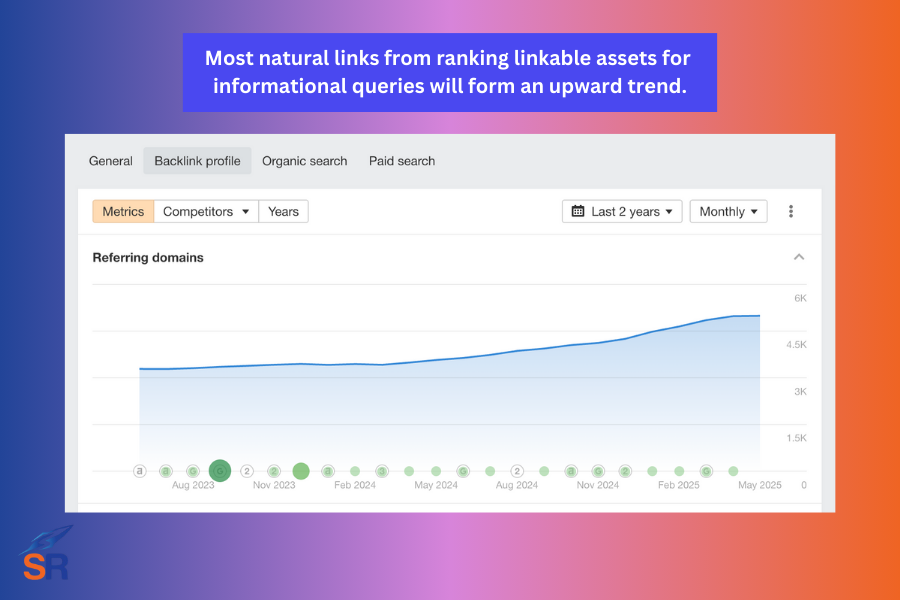
This pattern reflects a more natural backlink pattern, which you would typically find with most sites that have solid branding and reputation.
Match Link Building Efforts With Site Authority and Maturity
The best approach in managing link velocity is to anchor it to your site's current level of authority and domain age.
Acquiring hundreds of backlinks in the first month, especially without investing in topical assets to build your site's content library, looks unnatural. However, getting hundreds of links is more acceptable and often expected for established websites with higher domain age, currently ranking for industry keywords, and building foundational SEO work.
Recognize these maturity signals when deciding the volume of links and anticipating link velocity for your site:
- Growing library of topically related content.
- Increasing organic traffic and brand search volume (caused by the brand's offline marketing efforts and growing interest from ranking information pages).
- Number of trusted links from highly authoritative domains (DR60+)
- Frequent updates on the product or landing pages
Given that search engines evaluate context, not just raw numbers, matching your link velocity to your site's stage of development protects against penalties and sustains long-term rankings.
Pro Tip: Ramp up your link building efforts for new websites slowly - and as it gains more organic traffic from rankings, you can gradually increase links.
Use an Anchor Text Cycle Instead of Obsessing Over Ratios
Monitoring anchor text ratios is often a standard approach to managing link velocity and reducing the tendency to get penalized. However, micromanaging percentages can become rigid and resource-intensive, especially if you're managing several web properties or clients' websites.
A more flexible, straightforward approach is using the anchor text cycle.
The main idea is using rotating anchor text types month after month, instead of trying to hit perfect ratios - this reflects how natural link profiles develop their backlink profiles - gradually, unevenly, and are influenced by different content sources.
For instance, when building backlinks for a new website, you focus on building exact-match anchors to increase your page's topical relevance in the first month. Though it may seem contradictory, remember that building a single link doesn't automatically penalize your site. Then, in your second month, you can focus mainly on acquiring branded anchors. The cycle continues until you reach a perfectly balanced anchor text profile.
Rotating anchor texts focus helps distribute your optimization efforts without creating suspicious, over-optimized patterns.
Distribute Link Equity Across Multiple Pages
Link diversity is a healthy approach to ensuring that your site develops a more natural backlink profile by spreading backlinks across different pages, ones you intentionally want Google to acknowledge as your most important pages.
Here are two essential ways to do more link diversity for your website:
- Attract more inbound links to your informational content assets (not just your landing pages) by promoting them to target interested linkers (publishers, bloggers, journalists, etc) - seeing that a well-built online brand typically also gets natural links to its informational pages.
- Use internal linking to pass link equity to deeper pages or pages you want to rank for. You can use Ahrefs to find top-linked pages and build internal links from them to topically relevant but less internally linked pages.
Focus on Quality and Brand Association
While "quality over quantity" is standard SEO advice, it's often overlooked in practice for many SEO audits I've conducted for numerous clients' websites.
Earn and build the types of backlinks that truly reflect your brand's reputation.
A couple of tips to help you lean on backlink quality even more:
- During the link prospecting stage, ask yourself, "Would I want my brand mentioned on this site even if SEO didn't exist?".
- Set a list of link metrics your SEO team or outsourced link building agency will follow to ensure quality for backlinks.
- Prioritize providing value to more, but trusted, authoritative domains using different link building strategies and value-driven link outreach angles.
- Think long-term sustainable link building instead of a one-time off approach to chasing links.
Resilient Backlink Profile That Scales Safely
Focus on natural link acquisition, anchor text cycle, and aligning your link building efforts with your site's growth stage to create a resilient SEO foundation. There is nothing safer than positioning your link building campaigns as a branding effort instead of another chase to game the system.
If you're looking for more sustainable link velocity, explore our link building services and see how we can help.
Link Building Plan: 7 Steps to Better Backlinks (No More Guesswork)
Link building plan is the operational blueprint that turns your link building strategy into measurable outcomes, timelines, and specific actions required to acquire backlinks for your site - helping you achieve your campaign objectives.
Having a documented plan will help your team navigate their tasks and maintain focus, maximizing resources to scale your link building campaign and producing quality output that surpasses what your competitors can do.
A couple of reasons why link building plan is a must for in-house SEOs, agencies, and enterprise teams:
- It centralizes efforts on things that matter to the business - given that there are many routes you can take in link building, the links you get or earn must ultimately contribute to the overall business objectives.
- It pushes you to achieve as many quick wins as possible, especially for SEO agencies that operate on a pay-per-link model - knowing you'll have guaranteed links at the end of each month eases a lot of stress and ensures you're delivering on agreed-upon expectations.
- It helps you persuade internal stakeholders or clients to invest more budget in link acquisition, as they can see the value of the work right on paper - your link building plan.
- It measures your actions and adjusts elements of your tactics to create higher-quality links - without a plan, you wouldn't know where your campaign is failing.
Bring these compelling reasons to your link building plan.
Having a Strong Base
The success of any link building plan can be traced back to the SEO strength of the website and its internal capabilities to obtain or get backlinks.
Part of the link building plan is to ensure that the pillars of SEO are in place, so that links will have a more significant impact on their destination pages and the overall site's link equity and authority.
I won't delve into all fundamentals of SEO, but here are the ones you should prioritize:
- Crawlable and indexed pages by search engines (especially the most important pages and the ones you want to build links to).
- Produce helpful content assets you can later use as a value proposition in outreach or direct destination pages for links (from which you can include internal links to pages you want to rank for).
- Well-optimized pages (meta tags, headers, internal links, etc.) - for less competitive keywords, applying this basic optimization can help you show up in a good position on Google's SERPs.
- Optimize the page speed of target pages - as you only have a few seconds to impress your link prospects when you send content for link requests.
Apply basic optimization before any link building efforts to get the maximum value from your link building campaign.
How to Create a Link Building Plan
Now, let's go over how to create a link building plan:
1. Understand The Business, Target Audience, and Link History
Knowing your target audience (whether for your own site or your clients) is crucial to creating a link building plan that meets the exact needs of your target customers.
Given that it's possible to hit both the business goals and ranking objectives of your client when you acquire links from websites where your target customers are also engaging in ("hitting two birds with one stone").
The best way to learn more about your audience is by asking the right questions and gathering the correct information directly from your organization (for in-house SEO specialists) or from the client (for agency SEO).
Create a questionnaire you can send over to your client or internal stakeholders.
Here's a sample list of important questions:
- Who is your ideal customer? What are their demographics, interests, and online behaviors?
- What distinguishes your product or service from competitors? What value do you offer that others don't?
- Who are your main competitors in your industry?
- Have you previously engaged in link building or SEO efforts? What were the outcomes of those initiatives?
- Do you have existing relationships with influencers or distributors? How have these relationships been utilized in your marketing efforts?
- Are there any other details or insights about your business that could inform our link building strategy?
With these questions, you'll have a better understanding of the business, its target audience, and any previous link building campaigns (the ones that worked and that didn't).
Having all this historical data enables you to manage client expectations and set campaign objectives that are more realistic to achieve, which leads to the next step in creating a link building plan.
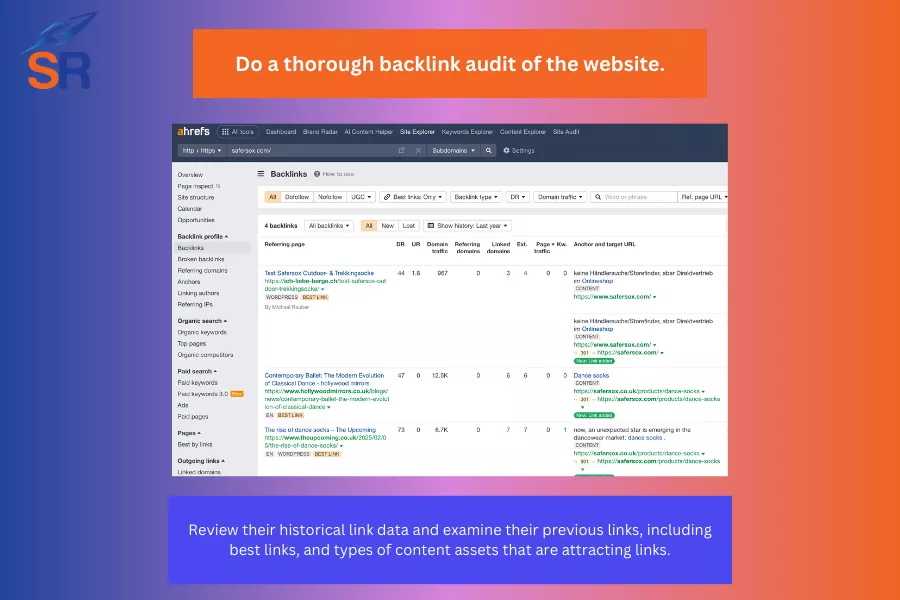
Pro Tip: One of our standard practices as a link building agency when working with clients is conducting a quick analysis of their backlink profile during the proposal stage - to review their historical link data and examine their previous links. It includes assessing:
- Top referring pages to see which pages are driving the most referral traffic - view this best in their Google Analytics data or Ahrefs' Top Referring Pages. These are the types of backlinks you need to get more of for your site.
- Types of content assets that are attracting passive links from publishers who are citing their work as additional references - build more of these assets and create a "flywheel" effect, and expect to have incoming links every month.
2. Set Your Goals and Campaign Objectives
Goal setting is what actually gives direction to your link building campaign.
And the most important goals for a link building campaign in achieving a holistic organic marketing campaign are the following:
- Improve the site's domain authority (DR) to have a competing ability to rank for its target keywords (both for commercial and informational terms)
- Generate more demand for the business by acquiring customers directly from referring pages and landing pages that rank well for their target keywords.
- Enhance brand visibility and recognition by being more visible for non-branded searches and/or increasing branded searches.
- Amplify the reach of specific content assets to gain more visibility, engagement, and opportunities to passively earn links by ranking for queries that publishers search for to find more resources.
Next, set campaign objectives based on these goals and your understanding of the business, its history, and the target audience, as outlined in step 1 of this link building plan guide.
These objectives are more actionable, realistic, and easy to understand, which you can include as the initial section of your document to send to your client or internal stakeholders.
Before I show you how to create these campaign objectives, let me first walk you through where we get data for setting campaign objectives:
Through Link Gap Analysis
What is link gap analysis?
Link gap analysis is the process of identifying the differences between your website's backlink profile and those of your competitors. It sets a clear benchmark for the number of links you need to build to specific pages of your site and helps you spot areas where your competitors may have missed or overlooked opportunities.
Link gap analysis aims to estimate the number of high-quality backlinks to target each month that meet specific metrics, such as sites with an Ahrefs Domain Rating (DR) of 30 or higher. This becomes part of your campaign objectives, focusing on both the volume and value of links you desire to pursue for your site.
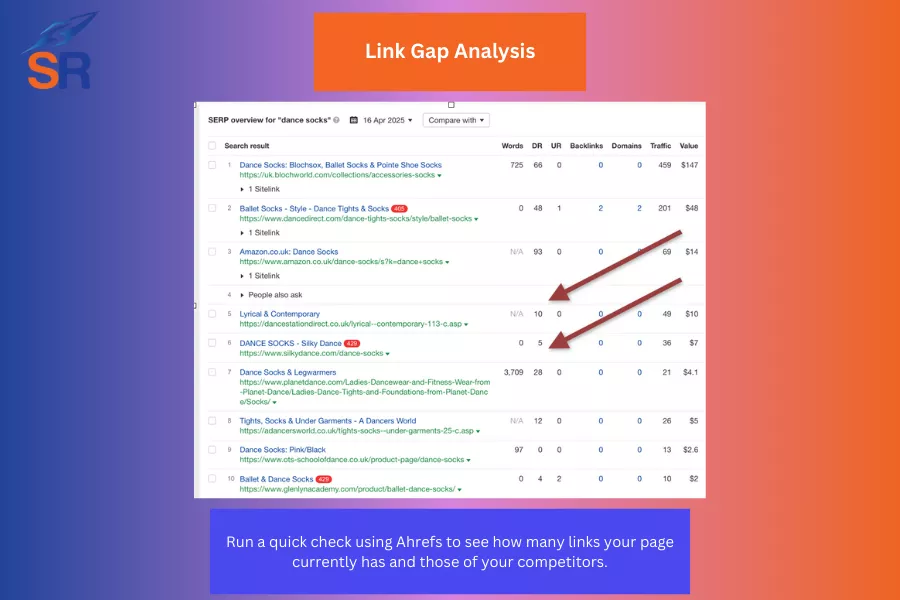
Start your analysis by selecting the page you want to rank for and identifying the top-ranking competitors for the page's target keyword. Ignore big competitors (i.e., big eCom brands like Amazon) and look for ones within your range of site authority.
Run a quick check using Ahrefs to see how many links your page currently has and those of your competitors.
Filter the links that/are:
- Come from sites with DR30+.
- Has traffic of at least 1K
- Within the specified target country/audience (if you're targeting local/international)
- In-content
- Dofollow
The remaining links from filtering are what you consider, conservatively, to be the number of high-quality backlinks to your page. Do the same for your top-ranking page competitors.
Then calculate the difference between these two numbers, which will give you the link gap count you should aim for.
For more detailed steps on how to do link gap analysis, check out our guide on competitor link analysis.
Define Campaign Objectives
Campaign objectives are the more granular part of your link building plan, as they deal specifically with what you want to achieve in your link development campaign that will impact your site's branding, SEO, and conversion.
Here are examples of campaign objectives:
Site Rankings
Obviously, the goal of link building is to improve target pages for both head terms and long-tail keywords. This is especially true for the key buyer terms your business or client wants to rank for.
Example of Campaign Objective: The main objective of this link building campaign is to rank for dance socks (and other keyword variants like “contemporary socks”, “ballet socks”, and “dancing socks”) in the UK.
Pro Tip:
As a link building consultant, I typically suggest achieving quick wins - keywords that are more achievable to rank given the current site's authority and its existing backlink profile.
And part of the SEO quick wins is utilizing internal linking to help important pages increase their keyword positions by adding internal links from other related pages.
Brand Sentiment and Reputation
Beyond rankings, you want to acquire links that will help improve your target users' perception of your brand - as this could also positively affect how you appear on AI platforms.
Example of Campaign Objective: We also want to improve the brand's sentiments and reputation for this website [SiteName] by only getting links from link sources you want your brand to be associated with, and focusing on the type of links and link placement on the page where you're likely to get clicks.
Link Velocity
One of the common mistakes I've seen SEO specialists make is aggressively building backlinks in the first few months without considering the site's current domain authority and potential risks associated with sudden spikes in link velocity.
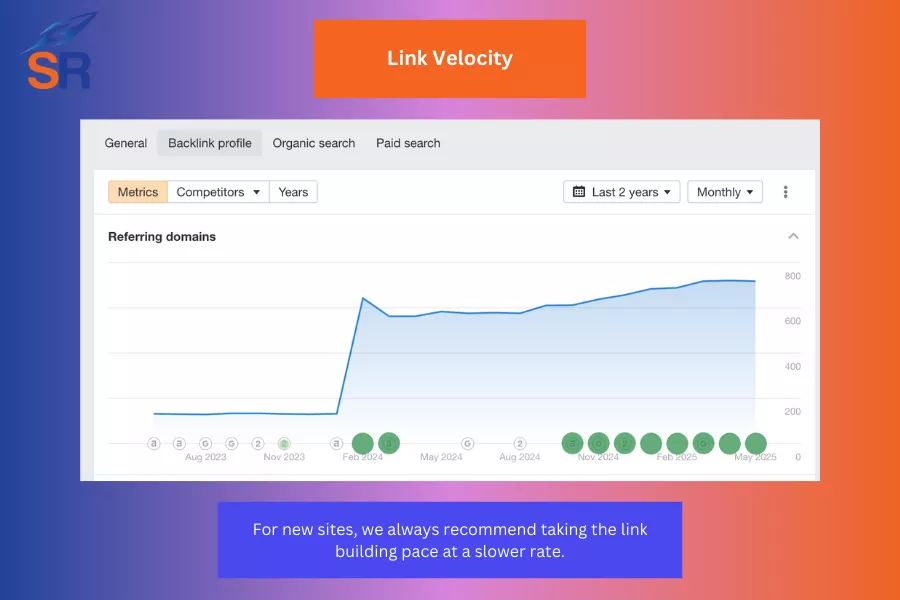
Unnatural link velocity can actually raise red flags in Google's algorithm, putting your site at risk of manual actions or algorithmic penalties, especially for new domains or sites with limited initial authority.
Example of Campaign Objective: Given the site's authority, DR5, we will focus on acquiring 10-15 contextual backlinks per month that align with the site's existing domain authority. This pace helps us ensure steady, sustainable growth of the site's domain authority while staying within safe thresholds.
Then, we gradually increase the pace as the site authority and organic traffic continue to grow (potentially from 15 to 25 target links).
Pro Tip:
For new sites, we always recommend taking the link building pace at a slower rate, with an average of 5 to 8 links per month (with 8 being the maximum).
We want to see the impact of these few links on their direct page. If there is a significant effect, we either increase the links pointing to the page until it reaches the highest position possible (the top 3 positions) or consider allocating other links to the site's other essential pages that may need a boost in rankings.
Link Diversity
The types of pages you point your backlinks to matter, especially in the early stage of the link building campaign - when you are still proving that the links acquired actually improve the page's search performance.
Our link diversity approach depends on the current site authority and its existing backlink profile.
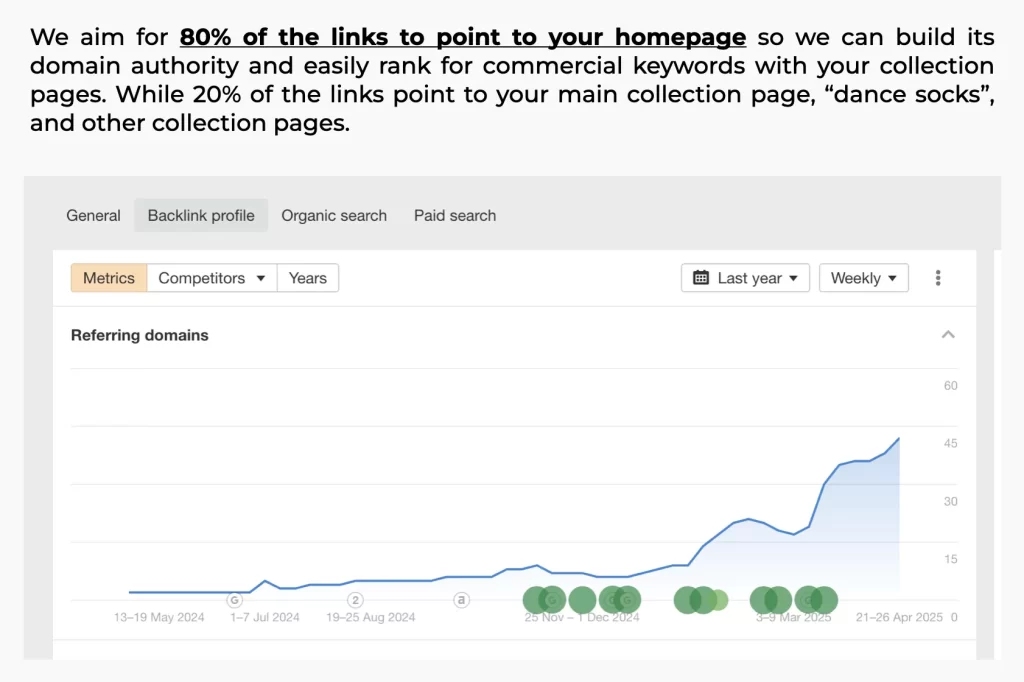
For new sites, we often recommend building the majority of the links (80%) to the homepage to boost its ranking power, while allocating 20% to the site's main product category or service pages - as it'll be much easier to contest for head terms when the website has a higher domain authority.
Then, as the site's domain authority grows, we will focus on building more links to product and service pages and blog content.
3. Identifying Potential Link Partners
Prospecting the right link opportunities is often the determining success factor of a link building campaign, as the value of a link depends on the types of people and sites that would link to you.
Use your link building campaign's objectives to direct your team to the right types of link sources. For instance, if one of your campaign objectives is to increase positive brand sentiment and improve your brand reputation, working only with publishers and entities you want your brand to associate with is essential.
Examples of these are:
- Potential brand partners (vendors, suppliers, future brand advocates, etc.).
- Trusted and authoritative voices in your space (authors, thought leaders, personalities, and in-house experts).
- Content creators with targeted communities (to absorb their social media followers and turn them into actual visitors or customers for your site).
Here are our best link prospecting methods, regardless of the industry of our clients:
Competitor Link Analysis
I wrote a detailed guide on how to do competitor analysis, but let me give you a couple of tips here:
Always start by reverse engineering competitors you can compete with - this means avoiding trusted brands that Google already favors (e.g., Amazon and Walmart).
Instead, target ranking competitors within your site's authority range. If you have a DR30 site, focus on competitor link analysis for websites with a domain rating (DR) between 20 and 60.
Another reason for choosing sites you have chances of competing is you want to be realistic as much as possible - the backlinks you get from reverse engineering mid-level competitors are easier to replicate given their existing resources and value proposition - since they aren't too far ahead of you in terms of authority, branding, and SEO budget.
Filter the links based on scalable link building strategies.
There are several link building strategies in SEO - both basic and advanced, where you can almost guarantee the conversion rate when doing outreach campaigns using those strategies.
Focusing on the type of links that a specific strategy targets can make the process easier when picking potential link targets through competitor backlink analysis.
For example, you can quickly check resource pages on the list by filtering words like "links" or "resources" and see if your competitor has acquired any links from resource pages. Or, if you want to look for "where to buy" pages for eCommerce, you can filter the list by "where to buy", "store list", and "retailer".
Leverage Link Intersect
You can automate competitor link analysis using Ahrefs' Link Intersect feature - it shows you the links pointing to your competitors but not to your site, giving you quick access to the list (instead of manually reverse-engineering competitors individually).
Link Search on the Web
Go beyond the usual competitor backlink analysis route and start looking for potential link sources that are relevant to your industry.
At SharpRocket, we're big fans of Ahrefs' Content Explorer. All of our team members are accustomed to using it to explore different advanced search filters, keywords, and variations, which helps us get the best results for potential relevant linking pages.
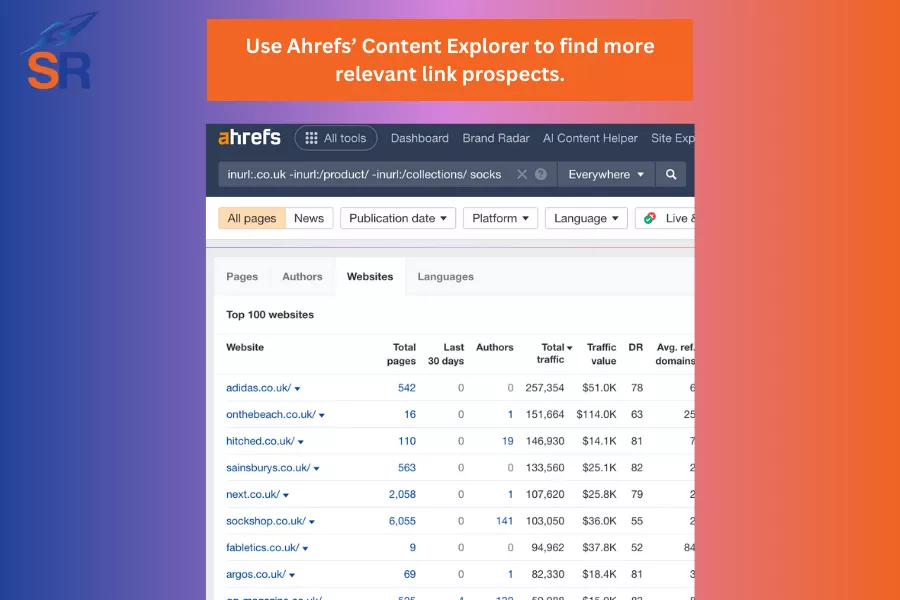
Target Active Authors
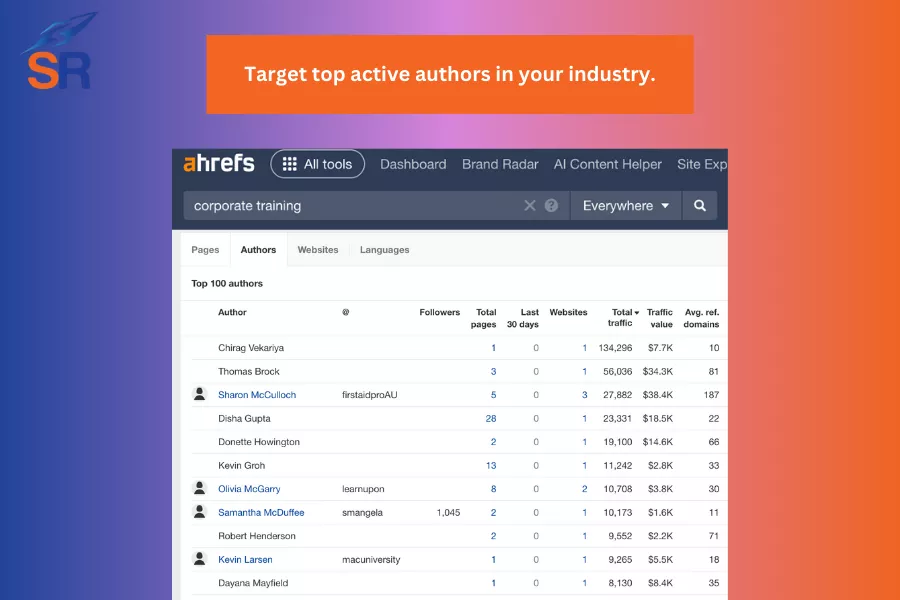
On top of exclusively prospecting for websites, you can also directly look for the top active authors in your industry.
The best part about this approach is that you can leverage these authors' existing networks and relationships, especially on the websites where they have already contributed content.
With many high-end, authoritative publishers with strict editorial guidelines — where they only accept experts and experienced contributors — you can penetrate these sites by contacting authors who already have published content there.
Brand Partners
Besides the typical link prospecting methods most SEO specialists use, i.e., competitor link analysis and manual or automated link search, spotting brand partners as part of your link prospecting list is still an effective way to build your site's reputation and topical authority.
The best links will come from domains that elevate your site's branding and reputation—these are link partners that target the same audience you want to engage.
The common mistake I've seen in-house SEO specialists make is ignoring sites with lower domain authority (i.e., those with an Ahrefs DR 20 or less), even if they are obviously topically or locally relevant to their brands.
Pro Tip: If you're not in the hustle of delivering guaranteed links every month (i.e., monthly link deliverables for link building agencies), you can go after these weaker brands but with higher brand and niche relevance, seeing that they have the potential to grow in the future in terms of authority and given the legitimacy and sustainability of the business they're in.
Here are some examples of low-authority but brand-relevant sites:
- New websites of legitimate vendors and suppliers in your industry
- Upcoming authors with targeted niche communities
- Social media influencers with unoptimized websites for SEO (but with assets you can leverage for content amplification and more brand discovery through collaboration and other co-marketing opportunities).
Client Block List (or "Do Not Contact" List)
One standard practice we integrate into our link prospecting process is creating a client blocklist, which is basically a list of all the websites we or our client don't want to reach out to.
Having this initial client blocklist as part of your link prospecting process can help eliminate inefficiencies in outreach. You don't need to spend time reaching out and following up with prospects from whom you don't want to get links.
A few examples of these websites are:
- Competitors that offer similar products or services.
- Affiliates and existing partners requested by the client for non-contact
- Referring domains already linked to the client's site - as the client wants all new backlinks to come from domains that weren't previously linked to their site.
4. Create Linkable Content Assets
I've discussed this part extensively in my guide on creating conversion-oriented, linkable assets.
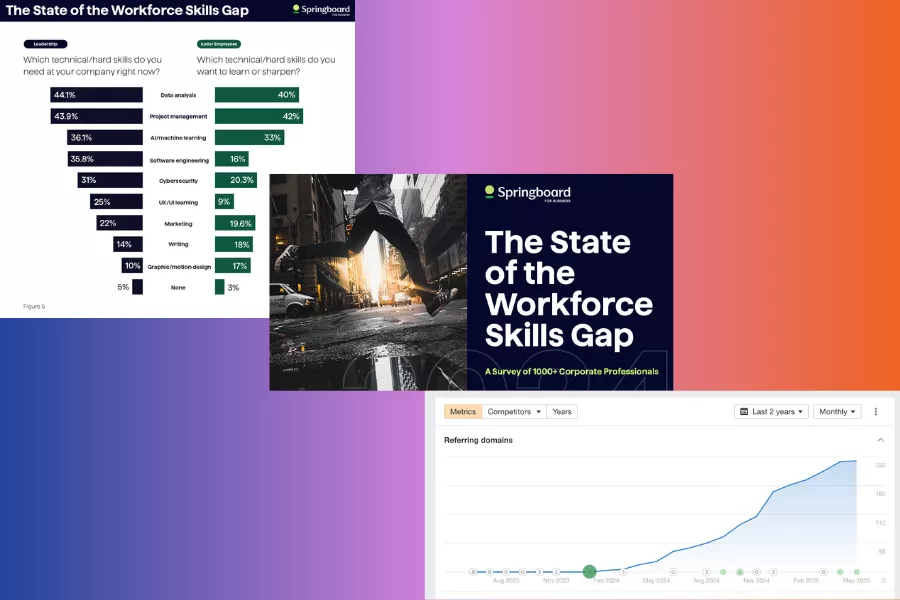
But here are some actionable tips:
- Tie the linkable asset to the problem you want to solve (i.e., Franchising 101 and 102 guides for my target coffee franchisees).
- Publish first-party data or insights.
- Identify the step before the solution
- Offer zero-friction tools or techniques that don't require emails to access (e.g., editable templates, checklists, scripts, and visual frameworks)
- Apply unique expertise to sales pages (e.g., use case scenarios, in-house scoring systems, internal testing protocols, etc.).
There are two approaches to leveraging linkable assets:
- Develop and use them as a direct value proposition for outreach, so that target websites link to these pages.
- Distribute the exact linkable content asset to selected link partners (i.e., choosing authoritative websites with a larger audience, email list, or social media following).
5. Manage Outreach Campaigns
Outreach campaigns are still effective in acquiring high-quality backlinks, but the approach has evolved over the years. This is because publishers and webmasters have detected the same patterns and outreach angles that most SEO specialists use to get links from them.
And since then, they have ignored the majority of pitches that offer the same intent or purpose in emails.
I've covered different angles and tactics in my guide on link building outreach, but let me repeat a couple of actionable tips here:
- Product-comparison add-on outreach.
- Content refresh and upgrade.
- Reverse outreach
- Stats-driven outreach
- Keep initial messages short. Brevity in outreach makes it easier to send semi-personalized mass emails while forcing your outreach team to focus on the value that matters most to your target link prospects (removing fluff and unnecessary introductions in emails).
- Educate publishers by using simple, non-technical terms, persuading them of the value of your content pitch - i.e., it helps increase their search traffic as your content targets a relevant keyword, which can rank and earn organic traffic.
- Stay updated with industry happenings and suggest more unique or highly specialized topics for guest posts not yet covered on their blogs.
6. Monitor Backlinks and Do Quality Assurance
The next step in your link-building plan is to monitor new backlinks to your site. These will come from webmasters you have reached out to using manual outreach or from publishers who cite your content as a reference in their articles.
You can manually check each domain in your outreach list for backlink monitoring or automate the process using link building tools like Ahrefs' Alerts and Mangools.
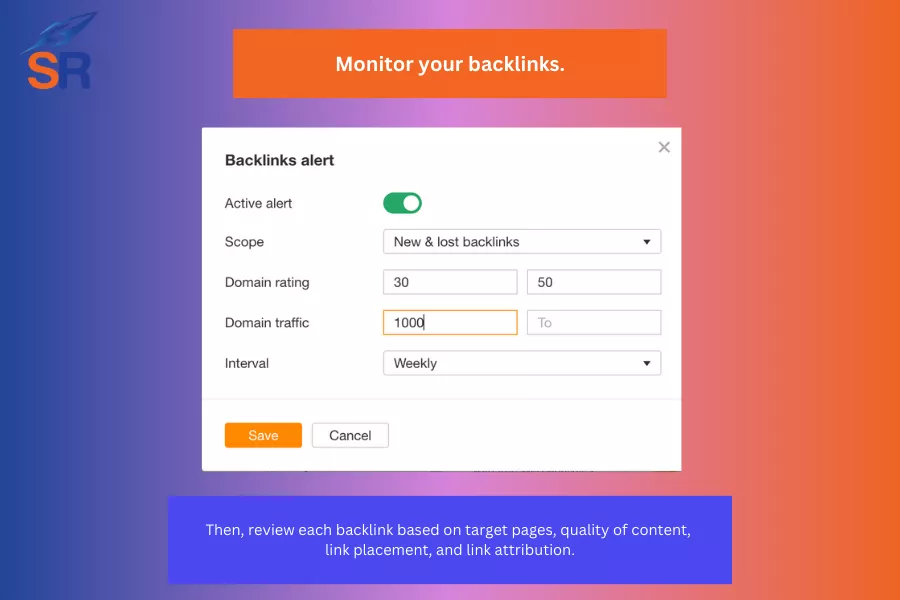
Part of good link monitoring is having quality assurance (QA) on the links placed, as one benefit of doing so is making early remedies for recently acquired links that don't meet the necessary criteria.
Review each live backlink based on:
- Target pages - the backlink must point to the target page of your campaign.
- Quality of content - conduct a second quality review of the content distributed to link partners (i.e., check if the guest post is well-optimized for SEO).
- Link placement - verify that the backlink has been placed (does the publisher actually link to you, or do they simply mention you without a link?) and is correctly positioned in the relevant section of the content.
- Link attribution (dofollow or no-follow attributes)
Checking the quality of backlinks will help you take remedial efforts, such as requesting to add links for unlinked mentions - a much better approach than doing outreach months after your brand has been mentioned.
7. Prepare a Link Report
Preparing a link report is the final phase of the link building plan, which is part of a monthly SEO strategy for in-house SEO specialists and SEO agencies offering link building services.
The practice of reporting live backlinks to internal stakeholders or clients has numerous benefits for both parties - SEO practitioners and those receiving the report, including:
- Increases buy-in for stakeholders and clients, as they can see the better value of every link acquired and how these links affect the site's entire SEO performance, branding, and organic revenue.
- Persuades clients and internal managers/directors to increase their link building budgets to tackle more competitive link building campaigns for high-value keywords.
- Forces in-house SEO teams to innovate by either A/B testing outreach copies or angles to increase link conversions, or trying new link building strategies from other observed industries where those strategies have proven effective.
Now, let's move on to preparing a link report.
A monthly link-building report isn't as glamorous as what other SEO bloggers try to portray. It is basically a collection of all the critical work you've done and future activities you want to pursue for next month.
Here's our recommended list of things you should definitely include in link building reports:
- URLs of published links
- Date when links were added (could be based on when the page was indexed, whether it's a new page, or the time of notification by the publisher/webmaster in emails).
- Link metrics in columns (Ahrefs' DR, site traffic, etc). - also include average DR for all links acquired
- Anchor text used in backlinks
- URL of backlinks' target pages
- Link building tactics used
- In-progress notes (i.e., waiting for approval for content created by your team)
- Next steps (i.e., continuous link prospecting and outreach, to publish specific linkable assets, or execute a new link-building strategy)
Plan For Link Building Success
The only way to guarantee success in link building is to plan and execute relentlessly - nothing else beats a well-thought-out link building plan.
Learn about our link building services and contact our experienced strategists to help build more backlinks to your website.
Value-Driven Link Building Outreach [Unique Angles You Can Use]
Link building outreach comprises most of the work we do in our link building agency. We still find it effective in landing link opportunities that our clients' competitors can't easily replicate.
However, the resources, efforts, and time it takes for outreach accounts to grow and produce backlinks for clients are the bottleneck that most SEO specialists and agencies find challenging to overcome.
Links should be a byproduct of helping people achieve their goals: visibility, rankings, and promotion of their offers. It means helping people. The offer, approach, and objective may change, but the primary purpose of link building remains the same: adding value.
As the typical "guest post" pitch no longer works, it's time to find new angles and innovative ways to increase the value of your link building outreach campaigns.
Value-Driven Link Building Outreach Tips
In this guide, I'll show you unique outreach angles we've tested that are way more effective than requesting straight-up links.
1. Brevity in Initial Pitch
The first email in link building outreach sets the tone. One of the most effective tactics is keeping initial messages short. There are a few advantages to this.
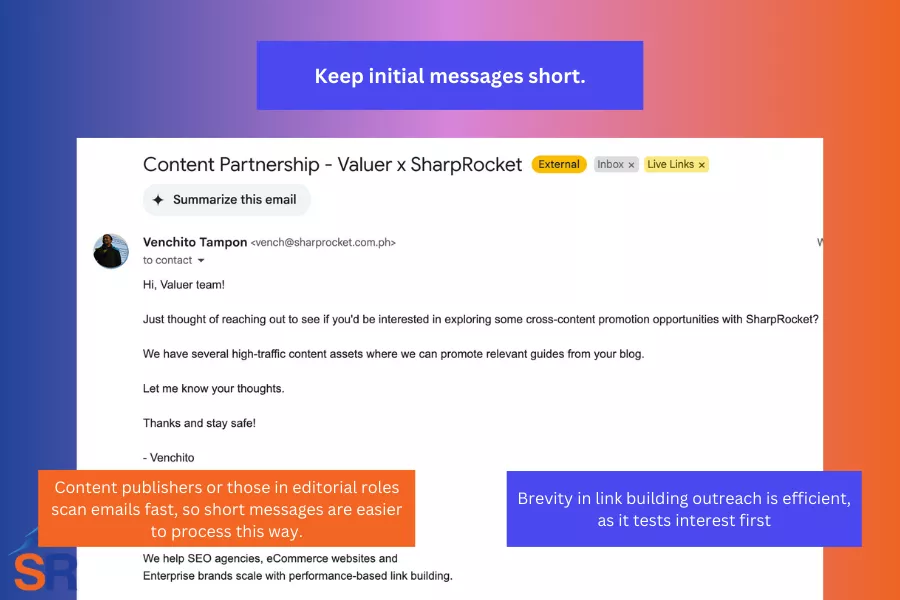
Long, overly detailed pitches create fiction and mental fatigue for busy publishers. Asking too much of the reader too early increases their resistance towards your pitch. When you open your pitch with a long email, you assume the recipient is willing to invest time in something they haven't asked for (reality: most won't).
Instead, keep your opening message tight and to the point.
Why brevity works in outreach:
- Leverage skimming: Content publishers or those in editorial roles scan emails fast, so short messages are easier to process this way.
- Increase response rate: A clear, focused ask is more likely to get a reply.
- Maximizes outreach time: You avoid spending too much effort on unresponsive contacts.
Brevity in link-building outreach is efficient, as it tests interest first. If they reply, you can then follow up with more detailed or tailored information.
In value-driven outreach, earning attention comes before earning a link.
2. Educate Publishers
Truly helpful content on the web educates. It is also why people link to pages in the first place: they find something useful that solves their problems or addresses their concerns.
In link building outreach, the same mindset can be applied to help people get more visibility.
One of the best types of linkers is legit brands and business owners. Google sees their websites as credible and more likely to be searched by its target users (branded and non-branded searches). As such, getting links from their business sites has higher link value compared to niche bloggers who don't have their built-in brand power.
In value-driven link outreach, education becomes your edge. Instead of requesting straight-up links, you can explain how reworking their current content that's been declining in traffic can be optimized for search and recover their traffic.
The plain reason is that most legit small brands aren't really knowledgeable about SEO. So sharing what you offer with them helps them gain more visibility and potential inquiries from ranking commercial keywords.
Use simple, non-technical explanations. Frame your "content improvements" angle as a favor to them, adding value to the conversations.
By actually giving them a reason to link, which is grounded in practical SEO benefit, you shift from a random stranger asking for a backlink to a helpful expert improving their content.
3. Content Refresh and Upgrade
Outreach is more effective when your offer improves what already exists.
Many websites have old blog posts, how-to guides, or listicles that still rank, but haven't been updated in months or years (which could position these pages higher in Google's SERPs once re-optimized). That's where content refresh outreach comes in.
Instead of pitching your link as just another resource, position it as a content upgrade (something that helps improve the page's quality, depth, and accuracy).
The outreach angle you're pursuing for this is the fresh update, that search engines reward and have been using as a ranking factor for years, to rank websites producing new, helpful content for their audience.
A few content refreshes or upgrades you can offer:
- New stats or data to replace outdated ones. It is also a good way to link to your larger data-driven content if it's thematically relevant.
- Missing section that covers a recent development. By getting immersed in the industry, you'll get updated with what's happening (more on this later).
- Visual (chart, infographic, flowchart) to enrich the reader's experience
- Deep guide that supports or extends an existing point.
Do the work for them. Rewrite the content with internal links to their site's other relevant pages (helping them get more visits on other content pieces).
» Want to take your outreach beyond templates? Explore advanced link building strategies in SEO that focus on relevance, value, and long-term results.
4. Be Updated with Industry Happenings
Immersion (as Jason Acidre coined it) is a strong factor differentiating your email outreach pitches from others.
Given that most SEO specialists and publishers will try to persuade blogs with generic topics. It would be an advantage if you knew the industry well and showed them what they're missing in the content. It adds more value to their audience and helps them differentiate their brand in the industry.
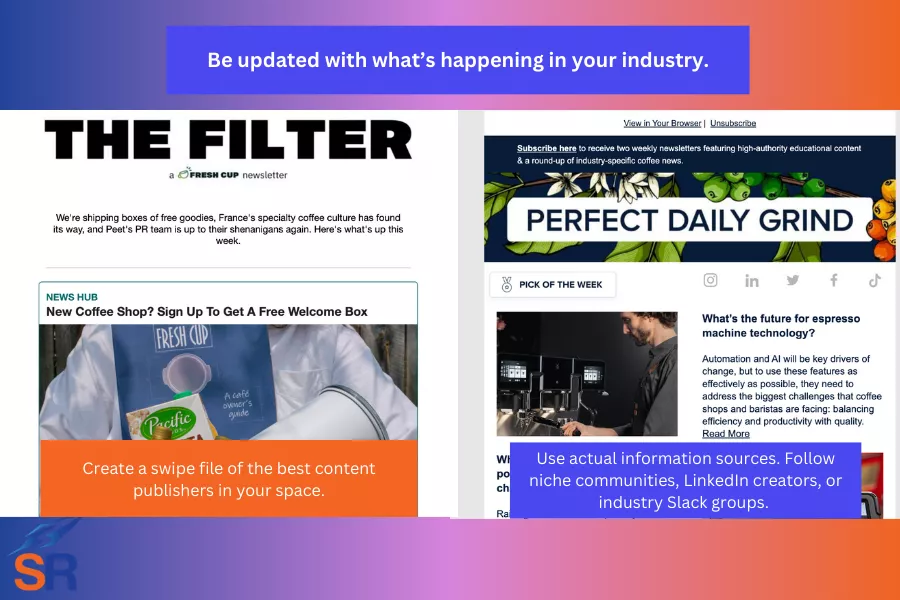
Create a swipe file of the best content publishers in your space. You can automate getting the latest trends, tips, and news by subscribing to their newsletters.
Here are a couple of ways to stay informed in your industry (even if you're not a subject matter expert):
- Be your own brand ambassador. Use your own experience if you're pitching for your brand. Get insights from customers' questions, sales feedback, and product updates (you know your business better than anyone else).
- Talk to people who know the space. If you're doing link building outreach for clients (or other teams), interview in-house experts, or sit in on internal training onboarding calls (just do whatever you can to get a real look at what's happening).
- Use actual information sources. Follow niche communities, LinkedIn creators, or industry Slack groups.
Once immersed in the industry, you can bring the knowledge into outreach.
The best thing about this approach is that when you reach out to publishers, most website owners won't spot content gaps unless they're fully involved in the topic.
This way, you can have so many outreach angles, including:
- Suggest updates to old posts that mention outdated tools or methods (share what tools have been highly reviewed in the industry).
- Recommended new angles based on emerging trends (rework their content)
- Offer data-backed resources based on recent studies.
Be like a consultant when pitching publishers, especially for new sites in the industry. You can help them by exploring new approaches to their content library.
5. Product Comparison Add-on
For eCommerce link building campaigns, this is one of the most high-impact link building outreach angles.
Given that getting links from posts that attract people who are actively searching, comparing, and making purchase decisions (i.e., Top X tools/products), especially those that rank well on Google's SERPs.
This outreach angle works because most round-up-style articles don't stay static. Publishers often (or want to) update them regularly, as they have the SEO benefit of driving consistent search traffic via rankings.
Help them with:
- Filling a gap in their current product listicle content.
- Adding new angles (e.g., best for beginners, best eco-friendly option)
- Reflects an emerging trend (e.g., AI features, sustainability, portability)
If your product has a unique POV, getting link placements from straight-up link requests would be easier. Provide more context on your product's unique value, which is suitable enough to be included in the list.
Create a list of product listicles. You can start by reverse engineering pages linked to your competitors' products (avoid the ones linked to big retailers or brands, as their websites naturally get links in the first place).
Find product list pages that are:
- Already ranking on page 1 or 2 for "best product" or "top product".
- Recently updated (check the date) or actively maintained (see "Last Updated").
- Missing your product or similar alternatives that your product improves on.
When doing link outreach using this angle, make your pitch stand out by:
- Positioning your product clearly (i.e. we're the best for XYZ feature").
- Frame it to benefit their content (i.e.," including us helps cover a broader segment of your readers").
- Make it easy for them to include your product (provide a quick smmary or suggested blurb they can copy and paste).
It's unlikely that your product beats others on everything. So, frame your angle to be best on a specific product feature or target customers. This would make specific relevance helpful to publishers trying to serve different audience segments.
» Looking for tools to streamline your outreach? Check out the best link building tools for SEO to scale and manage your campaigns efficiently.
6. Reverse Outreach
Outreach isn't enough to land more quality link placements. Especially if you're in a narrow niche, with limited publishers you can reach out to.
The best way is actually to create link opportunities yourself. That's where reverse outreach comes in.
Reverse outreach is a link building strategy where publishers initiate contact with you, not the other way around.
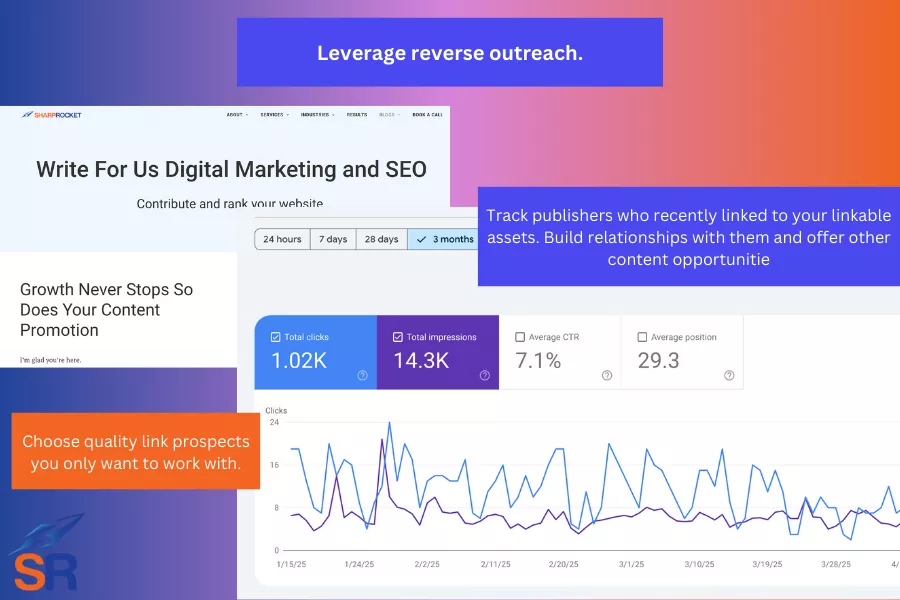
By ranking for keywords at the stage where they're writing their content or looking for references to add to their page, you would be found among the top-ranking pages in Google's SERPs.
The upside with reverse outreach is that you can control the value exchange, where you can:
- Choose quality link prospects you only want to work with.
- Have low resistance to link placement (leverage their desire for linking or content collaboration)
- Reduce outreach fatigue as you invest more in assets that do the prospecting for you.
- Scalable and sustainable (as it ranks and gets more visibility, the content can attract more passive link opportunities).
Create content that other people would cite as their resources, including:
- Original data or studies
- Free tools or templates
- In-depth evergreen guides
- "Write for us" or "Partner with us" pages
Another tip is to track publishers who recently linked to your linkable assets. Build relationships with them and offer other content opportunities, like collaborating on content, as both parties will certainly benefit from exposure.
» Need assets worth linking to? Learn how to create linkable assets that add real value and attract links naturally.
7. Stats-Driven Outreach
Data is one of the best reasons to update content, as it strengthens the page's credibility, makes it more current, and improves its chances of ranking higher in search results.
Stats add value to link building outreach, given that it or it has:
- Content freshness: Offering stats helps them refresh content without doing the research themselves.
- Fills missing context: You help them turn vague claims into precise, backed-up insights by inserting real numbers.
- Authoritativeness (E-E-A-T approach): When they cite credible sources or original data, it makes the publisher's page more authoritative.
- Do the work for them: Make it easy by writing the actual update or paragraph they can copy-paste with zero edits (offer that help upfront).
Don't have stats? You can curate stats using public government data and third-party data sources.
» Looking to get featured on real blogs? Check out our blogger outreach services that connect your brand with trusted publishers in your niche.
Link Metrics in SEO You Probably Don't Use Often
Vetting the right link opportunities and earning links from domains that truly matter starts with tracking the right link metrics. These metrics are actually what separate a successful campaign from a mediocre one.
If you purely rely on DR, which the majority of SEO agencies and in-house SEO teams use, you won't capture the full picture. A backlink from a high-DR site with zero traffic and irrelevant content often adds little value. Conversely, a link from a topically relevant website with focused content and real organic traffic, even if it has substantially lower DR, can move the needle in rankings and traffic.
Why Ahrefs’ DR Alone Is Not a Reliable Metric for Outreach?
In the early years of SEO, many SEO specialists (including me) relied on Google's PageRank. This algorithm, developed by Google's founders Larry Page and Sergey Brin, was one of the original algorithms used to rank web pages. It assigned a numerical value to each page based on the quantity and quality of backlinks, with the idea that a page is important if many other important pages link to it.
However, there was a time when PageRank stopped being publicly updated, so the SEO industry shifted to alternatives. Around 2010, Moz's Domain Authority (DA) became the popular benchmark. It provided a single number to estimate a site's authority, which was easy to report and track.
Today, the industry standard has shifted again. Ahrefs' Domain Rating (DR) is now the most commonly used metric by SEO specialists and trusted agencies. DR measures the strength of a site's backlink profile on a scale from 0 to 100, based on the quantity and quality of referring domains.
To balance it out, using Ahrefs' DR for outreach still has its advantages, and that's why most SEO agencies use it:
- It creates a fundamental level of domain reputation (e.g., aiming for DR25 or DR30+ links)
- It's visible at a glance with the Ahrefs toolbar (makes it easy to prospect for multiple link opportunities manually)
- It simplifies most performance tracking and team reporting (especially when working with in-house enterprise SEO teams).
Setting DR-based targets for link prospects is still the best approach. The only issue is relying on them alone while ignoring more accurate indicators of link value.
Here's why that's risky:
- DR reflects domain-wide strength, not page-level value.
- Google evaluates links based on context, relevance, and placement (factors not captured by DR alone)
- High-DR doesn't guarantee SEO impact (most of which, overused high-DR domains often have minimal effect).
We take metrics further as one of the best UK link building agencies.
When reviewing our list of link prospects, here are the link building tips and link metrics we consider (and you probably don't use often):
1. Check the Keywords They Get Traffic From
As you consider Ahrefs' DR of the website, review what keywords it ranks for. Use tools like Ahrefs or SEMRush to pull its top pages and top organic keywords. Both will show you whether the site attracts meaningful traffic from search terms relevant to your industry.
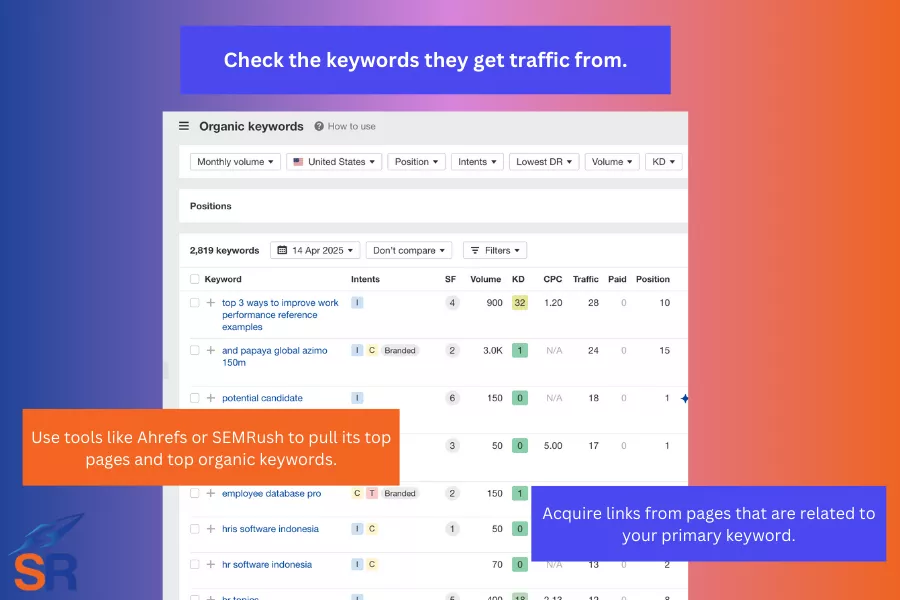
For example, if a marketing blog ranks for terms like "CRM tools for small business" or "email automation strategies, it's a strong signal that the site has topical authority (or at least has indexed pages with relevant topics).
However, if the top keywords are completely unrelated (or I may say, "spammy"), such as "online betting", or "essay writing services" (which by the way, I still see up to this date with some websites), that indicates the site is eiter overly commercialized, or part of a link scheme.
Checking keyword traffic can help you avoid websites that inflate traffic through unrelated or clickbait content (which is very easy to do). A site may appear active in terms of traffic and content publishing rate, but if its visibility is tied to irrelevant topics, the link carries little SEO value.
» Wondering how your competitors earn their links? Learn how to run an advanced competitor backlink analysis and find link opportunities they’re missing.
2. Contextual Relevance
Contextual relevance measures how well the linking page aligns with your topic, language, and intent content.
It's not enough for a site to have a high Ahrefs DR or strong traffic. If the content surrounding your link is off-topic, generic, or inconsistent with your industry, the link will have limited SEO value.
Here's what we look for in contextual relevance:
- Topical alignment: The linking page should cover a subject related to your content. For instance, if your page concerns project management tools, the link should come from a page discussing productivity, software, or workflow, not cooking tips or lifestyle hacks.
- Anchor text fit: The preferred anchor text should be natural and relevant to your target keyword (avoid forced placements or off-topic phrases).
- Surrounding content: The paragraph around the link should support and explain the linked page's topic.
- Minimal link dilution: Pages with fewer outbound links and a focused message provide stronger signals than link-heavy, general-purpose content.
The impact of contextually relevant links on your site compounds and benefits more than visibility. It helps Google better understand your website through contextual understanding of pages that link to your webpages.
» Want to go beyond basic outreach? Explore advanced link building strategies in SEO to earn high-quality links that actually move rankings.
3. Estimated Traffic of the Linking Page (URL-Level)
One of the main limitations of relying on Ahrefs' Domain Rating alone is that it scores the domain as a whole, but not the specific URL giving you the backlink. To better understand the link value (even by estimate), you need to check the estimated monthly traffic of the page that will link to you.
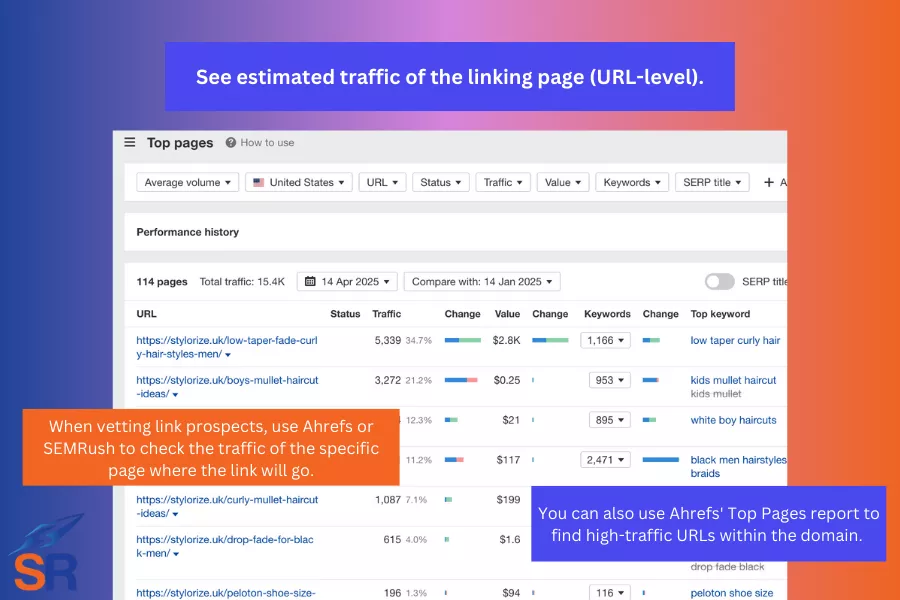
Here are a couple of benefits of using page-level traffic:
Identifies high-value pages on low-DR sites.
A low-DR website might publish one page that ranks exceptionally well, but is often dismissed by traditional link prospecting methods, given its average DR. Tracking URL-level traffic allows you to catch these hidden opportunities.
Rewards outreach to high-traffic pages.
A page-level traffic metric encourages outreaches to target a site's top-performing pages, which is a smarter move for SEO agencies to maximize the value from every link.
Compensates for recently launched or fast-growing sites
One of the overlooked parts of link prospecting is maximizing websites that are new or under-reviewed by Ahrefs, and have low DR, for that matter. But if its pages already rank and are driving organic traffic, those links are more likely to be valuable than DR suggests.
When vetting link prospects, use Ahrefs or SEMRush to check the traffic of the specific page where the link will go. You can also use Ahrefs' Top Pages report to find high-traffic URLs within the domain.
» Want to strengthen your existing backlinks? Explore modern approaches to tiered link building that boost link equity without using spammy tactics.
4. Aim to Get Dofollow Links (But Recognize Strategic Exceptions)
Even though Google has stated that nofollow links can be treated as hints (and are actual recommendations to the page/website), you can't rely on your link building campaigns on getting the majority to be no-follow links.
Especially if you're working for an SEO agency where clients are particular about the type of links you get, many SEO specialists don't count nofollow links as part of outreach KPIs. They only pay for do-follow links, as no-follow links are sometimes a by-product of an excellent digital PR campaign or other link building strategies.
Our best bet to be the default outreach strategy is prioritizing dofollow link placements.
The only exception is that many high-DR media outlets and authoritative news sites (DR70+) only offer nofollow links unless you pay steep fees. By also considering no-follow links, you get two key advantages:
- Builds relationships with top-tier publishers (intangible benefit, but can't easily measure) that can lead to future dofollow link placements, co-branded content, or digital PR features.
- Gain more branded exposure on high-traffic, trusted websites, where visibility can drive referral traffic, credibility, and long-term authority.
At best, aim for dofollow links by default, but don't ignore strategic nofollow link placements when they offer long-term brand and relationship value.
5. Link Placement Factors
As a link building consultant, I'm heavy on link placements, which is knowing where a link is actually placed on a page.
Given that Google gives more weight to links placed in the main content area, especially those that appear early in the content and are contextually relevant, it's one of the top link metrics every SEO specialist must consider.
Four important link placement factors we consider as a link building company:
- Position within the content: Links placed higher on the page or within the opening paragraphs tend to carry more weight—they are more likely to be crawled, seen, and clicked.
- Main body vs sidebar or footer: Links embedded in the main body text are far more valuable than those placed in sidebars, footers, author bios, or boilerplate sections.
- Surrounding content quality: The link should appear in a paragraph discussing the topic of your page (see our tip earlier on contextual relevance).
- Number of other outbound links: If the page has too many outbound links, the value is reduced to each one (fewer, more selective links indicate higher editorial standards).
Make it a standard practice to inspect where your link appears on the page. A higher likelihood of visibility helps attract more clicks and referral traffic to your destination page.
6. Outbound Link Profile Health
Outbound link profile health is the quality and relevance of the external links on a webpage, evaluating where a page is linking to, not just how many links it has.
Check where their external links go ("destination webpages").
Assess if the website links to quality, reputable sources or spammy, irrelevant, or suspicious domains (i.e., payday loans, crypto schemes, or thin-affiliated pages).
Outbound link profile health matters as it affects the credibility of your webpage. When your backlink sites include links to low-trust or manipulative websites, it sends signals that weaken your link's value (even if your own content on the page is strong and credible).
» Looking for tools to scale your outreach? See our list of the best link building tools for SEO that can help you build better links, faster.
7. Referring Domain Growth Trend
Check how fast or steady the linking website gains referring domains over time. If a site grows naturally, it suggests (probably seeing) that it's producing linkable assets and is seen as a credible source of information (its content assets are getting citations).
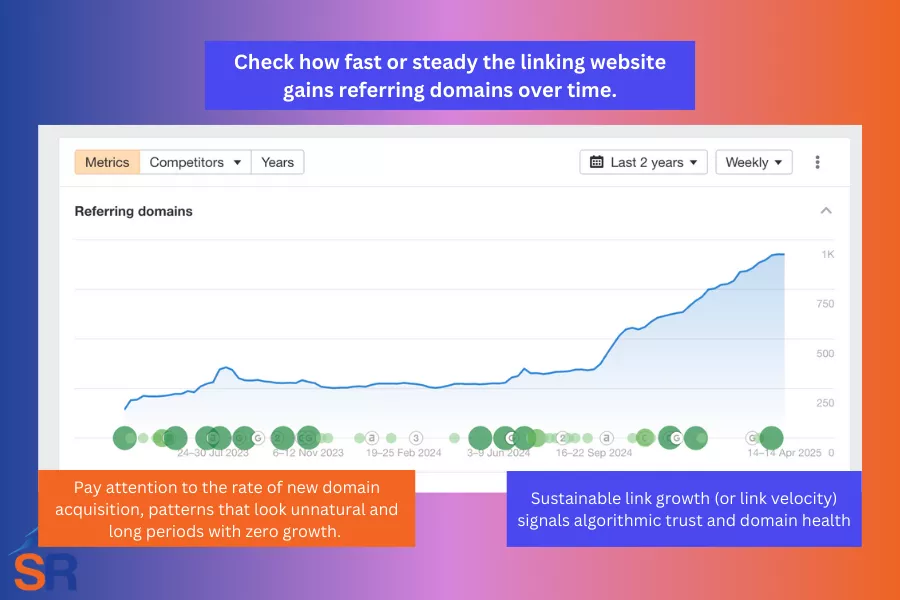
It's important to watch out for:
- Steady, upward trend: Indicates consistent publishing, link earning activity, and ongoing visibility in the niche.
- Sudden spike in referring domains Could be a sign of a robust digital PR campaign, aggressive link-building campaigns, or manipulative link-building tactics (see the site's backlink profile for deeper analysis).
- Flat or declining trend: Suggests the site may no longer be active in content publishing, lose its relevance in content, or not attract new organic links.
Use tools like Ahrefs' Referring Domains graph to review historical link data. Pay attention to the rate of new domain acquisition, patterns that look unnatural (i.e., 200+ new domains in one week, then none the next), and long periods with zero growth.
Sustainable link growth (or link velocity) signals algorithmic trust and domain health. Given that a website that earns organic links over time is being perceived as a highly credible source of information (vouched for by other niche publishers through their external linking efforts). While one website that grows too fast or stagnates may trigger a spam filter or lose ranking power.
» Looking for a trusted SEO partner to build high-quality links that pass the above link metrics? Check out our link building services designed to earn real, white-hat backlinks that drive results.
How to Create Conversion-Oriented Linkable Assets [+Examples]
Linkable assets no longer serve as pages "just to earn" links.
With our experience working with enterprise in-house SEO clients, we've seen the shift in the purpose of creating linkable assets. Beyond just attracting links to increase the site's authority (and improve rankings), they must also help move users through the customer journey and support the site's overall business goals.
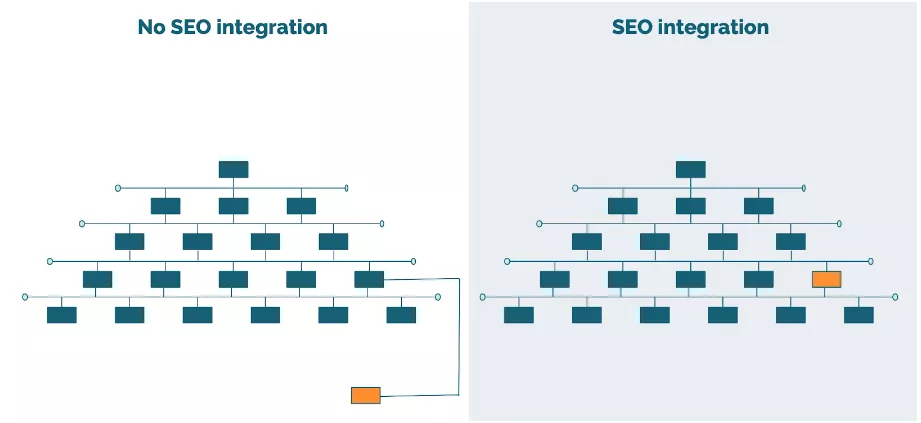
A Shift in Purpose
Before, linkable assets were built with one goal: to get links from other websites. SEO specialists were focused on creating content that would go viral, get picked up by journalists, or be featured in link roundups. Once the links were earned, the job was considered done.
The challenge is that many of these pages had no clear place on the website. They were often tucked away in corners where they wouldn't interfere with other content (which means they add little long-term value).
They were isolated. That approach no longer works.
Let me give you my new definition of linkable assets.
What are linkable assets?
Linkable assets are pieces of content created to earn backlinks while guiding users through key customer journey stages. They deliver practical value, such as templates, tools, data, checklists, or expert tips, and are built around specific user needs or early-stage problems. More than just informational, they’re structured to lead naturally toward a product, service, or next action.
Conversion-Oriented Linkable Assets
Conversion-oriented linkable assets target link acquisition efforts and assist conversions through the buyer journey.
Here are a couple of tactics you can test and implement for your brand:
1. Tie The Asset to a Problem Your Product Solves
For a linkable asset to drive traffic and conversions, it must address a problem that matters to your target audience and one that your product or service is built to solve.
When your content doesn't connect to the actual problems your audience faces (or the solutions you offer), it becomes isolated. It may earn a few links, but won't support your broader content strategy and brand authority.
Topping it off is the kind of traffic you want to attract from ranking with your linkable assets. It must be qualified traffic (people who are more likely to convert).
For instance, I've been heavily publishing franchising guides for my target audience - aspiring entrepreneurs- attracting passive links from other business bloggers and helping move visitors into the buyer journey (of inquiring about our franchise packages).
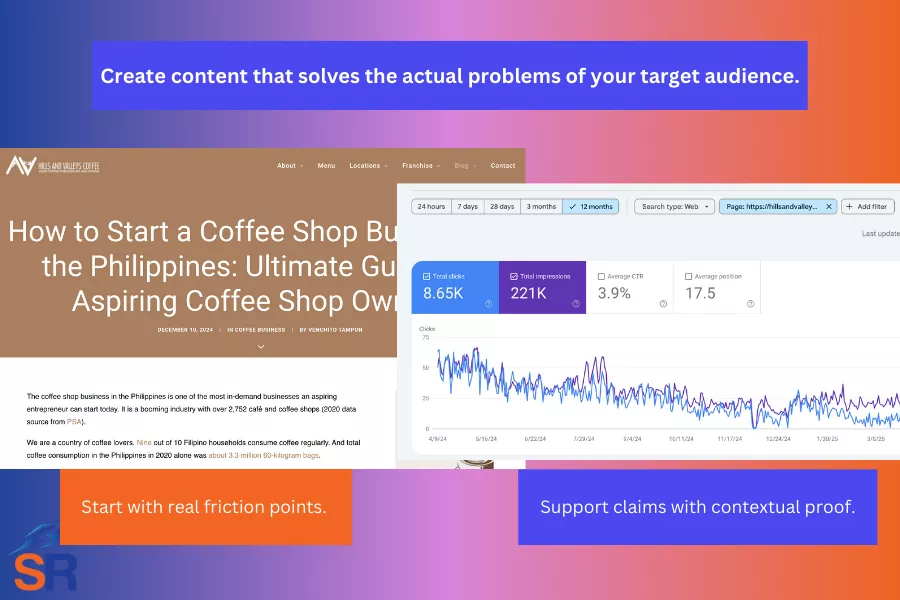
Start with real friction points.
Dig into support tickets, customer complaints, sales call transcripts, or onboarding surveys. These are all goldmines for uncovering the exact wording and issues your audience is already struggling with.
Solve one problem, not a category.
One citable element topic you can add to your landing page is content pieces that target one sharp pain point. These pieces are easier to share and connect to a product feature.
For example, instead of tackling "Remote Work Challenges", you can zero in on one like "missed deadlines due to unclear ownership", a quick section guide on "Why project deadlines slip in remote teams?").
Support claims with contextual proof.
Proofs are better than promises. Instead of just listing stats, show how the problem affects outcomes. Combine data with before-and-after scenarios, customer quotes, or use case breakdowns. One tip here is to use visuals like “problem → solution” timelines or annotated screenshots that can make technical solutions easier to grasp.
Optimize for internal link flow.
Do smart internal linking to pass link equity to your site's important pages. Link to supporting blog posts for depth (or next steps of resources) and link in from related product or resource pages.
2. Publish First-Party Data or Insights
Linkable assets that include first-party data stand out. You collect these insights directly from your audience, customers, or internal stakeholders. Given they're original and reliable, they can earn links that are hard to replicate by your competitors.
Most websites repeat the same statistics from popular blogs and reports, but when your asset shares data no one else has, you position your brand as a source instead of a mere distributor of information. This helps you draw attention and potential links from journalists writing industry stories, bloggers looking for original stats, and educators referencing niche topics.
How first-party data attracts links:
- Become the original source. Publishing unique data makes your site the primary reference point.
- Get cited in link roundups and other industry reports. Writers constantly search for new stats for listicles, "top trends," or "industry reports" (your original data gives them exactly what they need).
- Attract organic shares without manual outreach. When your insights are genuinely helpful, surprising, or time-sensitive, they provide a reason for people to share them naturally.
- Builds initial trust that earns links—the idea of having "statistics" itself initiates trust, as it is not something you can easily create without putting in enough work.
- Earn natural links from your brand's network. Customers, partners, and vendors may use your data in their business presentations, decks, and offline resources.
- Automate link building via ranking for stat-based search queries. Make sure you properly optimize your content for target stat keywords.
3. Identify the Step Before Your Solution
While the first tip of aligning your asset with a problem your product directly solves, another powerful approach is to go one step earlier:
Create content around the steps before someone needs your product.
These are research-driven, early-stage actions before they're ready to buy, subscribe, or engage.
Meeting them at the stage makes your content more than link-worthy. It becomes a bridge that connects their current challenge to your solution.
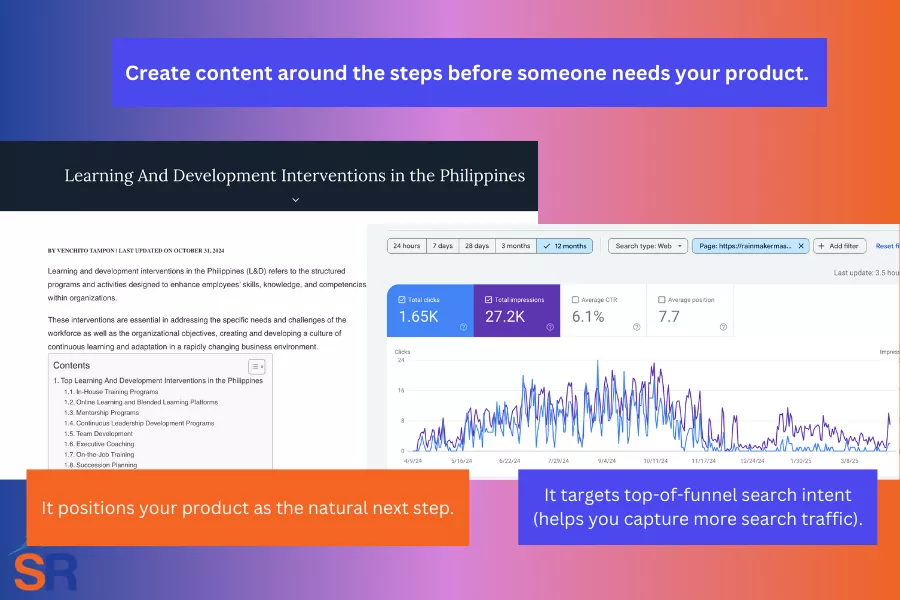
Why "before-the-solution" linkable assets work:
- It targets top-of-funnel search intent (helps you capture more search traffic).
- It attracts backlinks from educational and industry resources in your space.
- It positions your product as the natural next step
- It builds trust by adding value and genuinely helping people before selling
In creating linkable assets based on the steps before your solution, you need to understand your audience's decision-making process, not just what they need from you, but what they must go through before they realize your product is the answer.
Start by asking these questions.
1. What does someone need to understand, research, or prepare before they can use our product?
Think about the learning curve or awareness stage that your customers go through.
- Are they researching how to fix a specific issue?
- Are they comparing methods, tools, or strategies?
- Do they need to build a case internally before buying?
For instance, if you're doing a cybersecurity SEO campaign, you might identify that buyers first research "how to perform a security audit?" before looking for software, so a great linkable asset: "Step-by-Step Guide to Running Your First Cybersecurity Audit".
2. What issue or blocker do they typically face before they convert?
Identify the friction point that causes hesitation or slows the path to purchase:
- Are they unsure of what solution fits their situation?
- Are they missing resources, clarity, or approval?
- Do they fear making the wrong choice?
A good example of this is analytic tools (link building for SaaS), where you might discover potential buyers struggling to understand what metrics they actually need to track (creating a content asset on “10 Key Marketing Metrics Every Growing Business Should Watch and Why They Matter").
3. What content would help them at that point, and naturally lead to our solution?
Create content that meets them at that point with practical help. Shift from analyzing user intent to building a resource that solves their immediate need, without pushing your product too hard.
You earn links this way and create a moment of clarity where the reader thinks it is exactly what they need and sees if your website (brand) offers any solution.
4. Offer Zero-Friction Tools or Templates
Getting easy and early access to tools or templates people can use without barriers, signups, or complex instructions makes an asset linkable.
These linkable assets work because they deliver instant value, resulting in a resource that solves a specific, clearly defined problem.
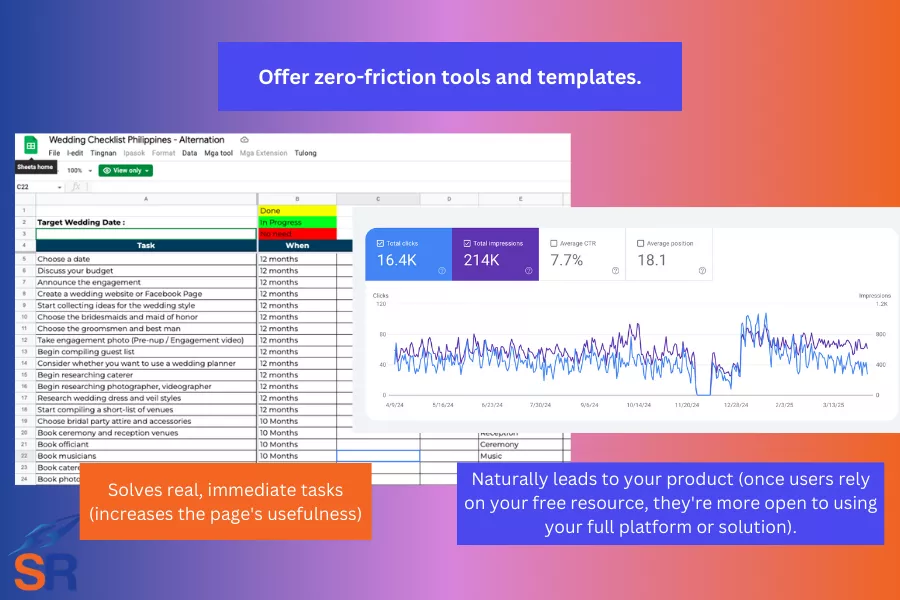
Why zero-friction tools are solid linkable assets:
- Solves real, immediate tasks (increases the page's usefulness)
- Easy to share or embed (content creators and publishers love linking to practical tools)
- Naturally leads to your product (once users rely on your free resource, they're more open to using your full platform or solution).
Here are a couple of formats of zero-friction tools or templates:
- Editable templates - Google Sheets, Notion, or Canva files that users can customize (e.g., 30-Day Social Media Planner Template)
- Checklists and worksheets - step-by-step guides, printable PDFs, or fillable forms (e.g., Product Launch Readiness Checklist)
- Mini tools and calculators - quick-use tools that help estimate or compare something (e.g., Email List Cost Calculator)
- Scripts and prompts - ready-to-use messages for outreach, sales, or communication (e.g., 5 Sales Email Templates That Get Replies)
- One pager and visual frameworks - simple visuals like flowcharts or decision-trees (e.g. Marketing Funnel Fix-it Flowchart)
You can optimize pages to include these zero-friction tools and rank for problem-solving queries, increasing your chances of earning more passive links through high rankings.
5. Apply Unique Expertise to Sales Pages
Use your team's specialized knowledge (research, process insights, etc.) directly on your product or sales pages. This will transform your standard transactional content into link-worthy referential material that adds value beyond the sale (and publishers will link to it, even if it is commercial in nature).
What to include based on your expertise:
- Proprietary scoring or rating systems
- Common mistakes your product helps prevent
- Internal benchmarks or quality thresholds
- Use-case scenarios from support or onboarding logs
- In-house tips, techniques, or shortcuts
- Chronology or iteration history of product development
- Decision-making frameworks used by your team
- Internal testing protocols or standards
- Product-specific troubleshooting insights
- Expert-recommended usage routines or best practices
One good example, if you're doing eCommerce SEO, is publishing a best practice angle:
“Our in-house ergonomics team recommends adjusting the chair height so your elbows form a 90-degree angle while typing. This position reduces shoulder tension and improves long-term posture. That’s why our chair includes a guided adjustment checklist under the seat.”
This example draws from expert-recommended usage routines, which address a common user challenge - a value-add to your product page, reinforcing your brand authority.
Need help with your link building campaigns? See our link building services and let's have a free strategy call.
Modern-Day Tiered Link Building: Link Stacking (and Smarter Alternatives)
Traditional tiered link building no longer works. Creating backlinks to levels of linking pages to your website was once a way to improve site rankings through layered authority.
In the past, SEOs built links not just to their website but also to the pages that linked to them, referring to Tier 2 and Tier 3 links, in which the goal was to increase the power of Tier 1 backlinks and pass that strength down the chain.
How search engines like Google perceive and recognize backlinks today has evolved.
Why Traditional Tiered Link Building Doesn't Work?
While it's a systematic approach to link building, traditional tiered link building no longer works for many reasons.
1. Link Decay and 404 Errors Break the Chain
Backlinks are not permanent, as the web is constantly changing. Pages get updated, deleted, or moved, particularly during this time when the rate of content publishing has accelerated. This means that your Tier 1 backlinks (the ones linking directly to your site) can eventually disappear. When that happens, the entire link chain breaks.
If you've invested time or money building Tier 2 links to boost a Tier 1 page, and that Tier 1 page goes offline (returns a 404 error or gets redirected), all the value from those Tier 2 links is lost. Google can't crawl through a broken link to reach your site. As a result, the link equity stops flowing.
The challenge with this scenario is that it becomes worse over time. As websites restructure or remove content, the likelihood of link decay increases. Even high-authority sites can remove pages without notice. So, if your entire strategy depends on supporting a Tier 1 page that's no longer active, you risk highly of your backlink profile.
2. Direct Links Pass More Value
In today's SEO landscape, Google gives more weight to backlinks that point directly to your website, especially when those links come from authoritative, relevant sources.
When a site links to your page, Google views that link as a clear signal of trust, relevance, and endorsement. It's direct, easy to crawl, and tied to content that users can immediately access. These links carry more ranking power and help improve your site's visibility in a more predictable way.
Conversely, indirect links (those that are buried in a tiered structure (Tier 2 to Tier 1 to your site), lose their strength as they pass through multiple layers. Every jump from one page to another dilutes the potential link equity. If the Tier 1 page isn't indexed, lacks authority, or is poorly optimized, even a strong Tier 2 link won't help you. The benefit of layered link building stops before it reaches you.
A direct backlink embedded in meaningful content will outperform a tiered link structure built on low-value pages.
3. Contextual Relevance Matters More Than Structure
Google focuses heavily on contextual relevance. With hundreds of backlinks we build every single day with our link building agency, we've observed quite well how powerful relevant backlinks are to the website.
A backlink placed within content that matches your topics or industry will pass more value than one that's technical "part of a tiered system."
Google is better at understanding what content is about, so it expects backlinks to come from content that's thematically aligned with the target page. For instance, if your site is about dental software, a link from a healthcare IT blog will be more valuable than one from a fitness receipt site (even if both pages technically point to your content).
Traditional tiered link building fails here because it often prioritizes link quantity over contextual quality. The end result is a chain of weak signals instead of a strong, relevant recommendation.
4. Harder to Track ROI and Value
When the strategy involves creating multiple layers of backlinks (Tier 2 to Tier 1 to your site), it becomes challenging to identify which links are actually making a difference.
Let's say you build 10 tier 2 links to a blog post (Tier 1) that links to your site. Your rankings slightly improved, but where did the lift come from? Was it the Tier 1 link itself? Did one of the Tier 2 links influence it? Was it due to another backlink if Google found it elsewhere? There are no clear, direct signals to measure.
The more layers involved, the harder it is to isolate what's working, making it extremely difficult to assess the return on investment on link building.
You need to know where your gains are coming from so you can focus on what works and eliminate what doesn't. Tiered link-building strategies blur the bigger picture and create too many unknowns.
Link Stacking: Modern-Day Tiered Link Building (and Smarter Alternatives)
While traditional tiered link building is outdated, the core idea of strengthening your most valuable backlinks is essential for link development; we call it "link stacking".
What is Link Stacking?
Link stacking is the strategic practice of amplifying the value of your strongest backlinks and replicating them more often by increasing their visibility, authority, and contextual relevance, without relying too much on artificial link structures.
Link Stacking Strategies That Work
Here are proven link-stacking strategies that work in 2025.
1. Identify and Replicate High-Impact Backlinks
The best way to start is to know which backlinks are worth amplifying and replicating. Run a backlink audit using link intelligence tools like Ahrefs, SEMRush, and MajesticSEO (see our hand-picked link building tools for SEO).
See backlinks from authority domains, driving real referral traffic and pointing to the most important pages (or your blog content, acquiring search traffic via ranking for informational queries).
Replicate these high-impact backlinks that have been driving significant value to your site (as doing more of them can help improve more of the metrics you're looking at—referral traffic, rankings, brand visibility, etc.).
Study the content that earned the highest-impact links. Is it a how-to guide, a case study, a list of tools, a data-driven piece of content, or a citable element on a landing page?
Once you've identified the format and topic that attracted backlinks, create more content using the same structure and angle but more focused on new subtopics, updated trends, or related industry keywords.
For instance, if a list of "Top CRM Tools for 2025" earned strong backlinks, follow up with "Best CRM Tools for Startups"—these are pieces of content tailored to your target persona and aligned with the user's buyer journey.
2. Do Smart Internal Linking
The authority on the page where you get the most links doesn't have to stay confined to that page. You can use smart internal linking to direct some of that value to other important pages on your site.
Revisit your blog posts with the highest number of referring domains, resource pages with backlinks from authority sites, and landing pages that earned natural citations or mentions.
Add contextual internal links to the most important product/service pages, newer blog posts that need ranking support, and categories (or hub pages) that build topical depth.
You can add sections such as "related sources" at the bottom, embedded videos or downloadable tools, and internal navigation to deeper subtopics. Doing so increases the number of pages per visit, improves your site's crawlability, and efficiently spreads SEO value across your content ecosystem.
3. Distribute Content Targeting Keyword Variations of Your Core Topic
One way to scale your link stacking strategy is to create and distribute content that targets keyword variations related to your primary topics. Instead of repeating the same angle or keyword focus, this approach allows you to cover more ground and reinforce your site's authority on a subject.
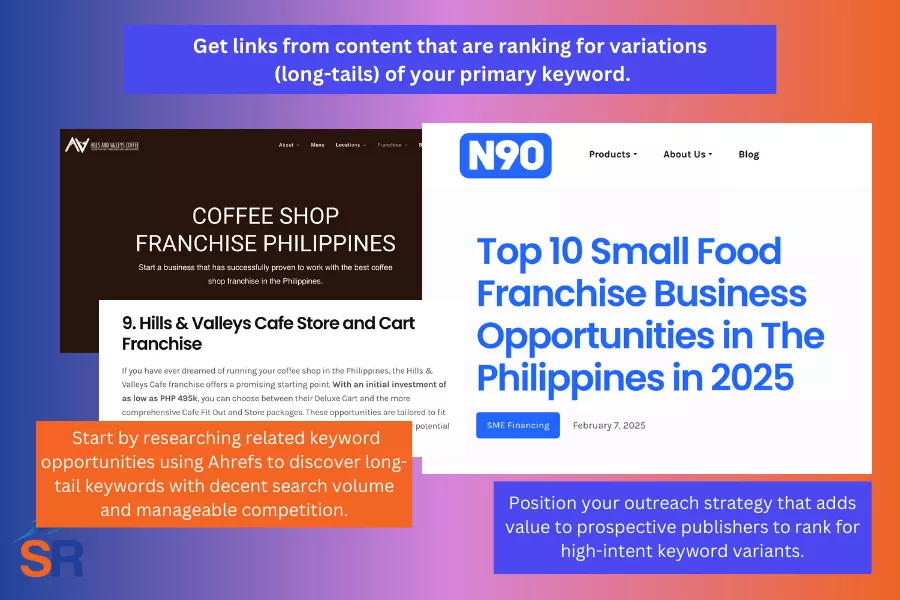
Google rewards topical depth, so as you consistently publish and earn links for content around a central theme, you start building your site's topical authority (off-page).
Identify keyword variations with potential. Start by researching related keyword opportunities using Ahrefs or SEMRush to discover:
- Long-tail keywords tied to your core topic
- Variations with decent search volume and manageable competition
- Subtopics that address specific segments, pain points, or use cases
For instance, if your primary keyword is "project management tools," variations might include "project management tools for remote teams" or "free tools for agile project workflows."
Do value-driven outreach.
Instead of simply soliciting backlinks, take a smarter route of offering to publish content on their site that targets keyword variations of your shared niche. The upside is that it's geared towards the value it could bring to the table, benefiting your target publisher.
Mid-level publishers need more search traffic and quality content that ranks for new long-tail keywords optimized for underserved but high-potential queries.
You provide all that by offering content that targets specific keyword variations, ones with clear search intent and volume that may not be covered yet.
By positioning your outreach strategy that adds value to prospective publishers to rank for high-intent keyword variants, you increase the likelihood of higher responses and link placements that directly improve your site's ability to rank for your primary keyword (as distributed content is topically relevant to what you're trying to rank for).
4. Turn High-Performing Content Into Multi-Format Linkable Assets
When a piece of content earns strong backlinks, it clearly signals that it holds value for both users and publishers. You can multiply its link potential by turning it into various formats that attract different types of audiences, learners, and content creators.
Repurposing content pieces is a strategic link-stacking move to get more backlinks from more platforms using content that's already proven to work.
A few formats you can consider:
- Infographics - visual summaries of stats or steps from your post
- PDF guide or downloadable - useful for resource pages or B2B listicles
- Slide decks - add more visual depth
- Short-form video - condense the content into explainer or how-to videos (which you can also upload to YouTube and earn organic social traffic).
By turning high-performing content into multi-format assets, you also increase the surface area of discovery through LLM's AI models. The more accessible and multi-platform your content is, the higher the chance it gets referenced in AI-generated answers, included in citation stacks from AI tools, and more often suggested by Google's AI Overviews.
Schedule a free strategy call if you're looking for the best link building agency in the UK.
White Label Link Building Guide for Agencies: Process and Best Practices
I've had conversations with companies and SEO agencies directly outsourcing their white-label link building projects to developing countries like the Philippines, where a skilled team can deliver topically relevant backlinks at a lower cost.
Without building an internal outreach team, these agencies want to scale fast, meet client demands, focus on their core SEO strengths, and keep profit margins healthy.
White label link building services allows them to do exactly that. They focus on client relationships, strategy, and reporting while their offshore team handles the heavy lifting: prospecting, outreach, content writing, and link placement. This setup works well for both sides and is becoming a common business model in the sEO industry.
In this guide, we'll cover what white label link building is, who uses it, how it works, and waht to look for in a provider. If you're an agency looking to grow without hiring, this guide is for you.
What is White Label Link Building?
White label link building is an offshore service where the SEO provider builds backlinks on behalf of another agency. The agency delivers the results to its client under its own brand, putting all the legwork for its link-building partner.
Who Uses White Label Link Building Services?
White-label link building is widely used by service-based agencies that want to offer SEO without doing the actual link building work. These businesses resell link building under their own brand while a third-party provider does the research, outreach, and content placement.
Here are the most common types of users:
1. SEO Agencies
Some SEO agencies handle keyword research, technical audits, and content strategy but outsource link building to save time. Instead of fully hiring an outreach team, they work with a white-label partner to build the right types of backlinks at scale.
2. Digital Marketing Agencies
Agencies that focus on social media marketing, paid ads, or email marketing often add SEO to their mix of services. Since link building requires a separate skill set, they use white-label providers to deliver results without hiring more people and creating a new set of in-house processes to train link buliding specialists.
3. Web Design and Development Companies
Web agencies build websites and often get asked by clients how to rank better on search engines like Google (and show up on LLMs like ChatGPT and Perplexity). Instead of saying no or referring the client elsewhere, they offer link-building through a white-label provider and keep the business in-house. They operate this way to increase their client base and get more margins.
4. Freelancers and Solo Consultants
Freelancers who manage SEO for clients may not have the time to do outreach or write external content ("guest posts") to acquire backlinks for their clients. With white-label support, they can take on more clients and deliver results faster.
5. Startups and Niche Service Providers
Smaller agencies or startups that are growing quickly may not yet have full SEO capabilities, as many are focused on product or service delivery, other marketing channels, and customer service.
White-label link building lets them offer results-driven services while focusing on client relationships and sales. It also enables another B2B type of service (offering SEO services besides their core product offerings).
Benefits of White Label Link Building for Agencies
White label link building gives agencies a clear path to grow their SEO services without increasing internal workload. It's a practical way to meet client demands, keep operating expenses low, and improve performance—all under the agency's brand.
Below are the most important benefits of hiring a white-label link-building partner.
Scale Without Hiring
Many agencies hit a ceiling because they lack the resources, team, and capabilities to handle high-volume link building. Hiring, training, and managing a full-time outreach and content team takes time and money, let alone taking months to fully systematize the process and quality of results.
White-label link building actually removes this barrier. Agencies can serve more clients, take on larger projects, and expand their offerings. This makes it easy to grow from 3 to 50 clients without changing internal operations. The partner handles execution, while the agency focuses on client acquisition, account management, and reporting.
Faster Project Completion
Link building involves many steps: link prospecting, backlink qualification, outreach, content creation, and outreach follow-ups. By leveraging white-label link building services, you take these steps systemized. They have outreach templates, active contact lists (relationships with publishers, bloggers, and journalists), and content teams ready to work.
You can report all lives links at the end of each month (as part of your SEO reports), avoiding delays that comes with lack of manpower and capabilities for in-house link building.
Lower Costs and Better Margins
Building an internal team involves fixed costs: monthly salaries, software subscriptions (e.g., Ahrefs), training, and management overhead. White-label providers operate on a per-link or per-campaign basis, making the costs of outsourcing more flexible and predictable.
Agencies can simply mark up the service and offer it to clients at a profit, increasing the overall revenue without adding extra burden to the team.
Access to Experienced Link Building Experts
White label providers specialize in link building, many are fly-by-night companies, but there's still a handful of best white label link building agencies like SharpRocket that truly has mastered the craft of link development.
They have rigorious processes, systems, high-level capabilities, and inside-know hows for every industry, that strengthens their core service in providing the highest quality of backlinks.
So, agencies gain access to this type of expert-level service without spending months building even the basic skills themselves, which ensures links meet the quality standards.
Your Branding, Your Reputation
White label means the client never sees the third-party provider, this both takes pros and cons scenario, where if the agency fails to meet the link requirements, it could negatively affect the branding of the agency and failing to meet desired expectations and results.
However, if they hire the right white label link building partner, and it delivered what they agreed upon, it significantly impacts the agency's reputation, building client trust even more, and avoids any confusion about who's doing the work—this keep the agency's brand front and center.
How It Works: The White Label Link Building Workflow
There's nothing complicated with white-label link building. If follows a clear process, where the agency manages the client, the provider manages the links. The clients sees the results, but only the agency's brand is visible.
Here's how the process usually works, step by step:
Step 1: The Agency Signs a Client for SEO Services
The agency offers SEO services to its clients, or upsells it from another service they already render. For instance, after working on a website revamp, they found issues to solve, by optimizing better their client's website to help them gain more search traffic.
As such, they offer a full SEO package that includes technical SEO, on-page SEO, content strategy, and link building. When a client signs up, the agency includes link building as part of the package, even if they don't handle it in-house, or if they do, they don't have the capability to scale the work.
Step 2: The Agency Submits a Link Building Request to the Provider
The agency sends a request to the white label partner, which includes links that pass on certain link metrics (e.g. Ahrefs' Domain Rating, organic traffic (estimate), topical relevance), as well as the number of links pointing to desired target pages.
Some providers, with SEO consultants, suggest link targets or provide recommendations as to how many backlinks to build each month based on the client's website domain authority and how fast to acquire links ("link velocity").
Step 3: The White Label Provider Handles Prospecting, Outreach and Content
The white-label link-building agency starts and executes the actual link building process, which includes:
- Finding relevant websites in the client's niche (link prospecting)
- Qualifying backlink sources based on set link metrics
- Reaching out to editors or site owners (email and other forms of link outreach methods.
- Pitching for either link inclusion, link request, or value-add outreach forms (i.e. content, data, visual assets, co-marketing, etc..).
White label partners share a live dashboard or spreadsheet that shows every live link each week and provides a detailed backlink reporting at the end of every month (or agreed timeline for reporting).
Different agreements between agency and provider has unique expectations, timelines, and deliverables in their own right. However, having a good workflow will help agencies stay efficient and effective, so they can focus more on agency growth, communication, and strategy.
Risks and How to Avoid Bad Link-Building Providers
White label link building can certainly help your agency, but only if the provider delivers top quality. Bad links can negatively affect your clients' rankings, trigger penalties, or lead to lost trust (and of course, waste of money and resources).
Below are common risks and how to avoid them:
Spammy or Low-Quality Links
There are many fly-by-night agencies that offer cheap links, mostly placed on PBNs (private blog networks), link directories, or websites with poor content and low authority. These sites often exist only to sell backlinks and have no real audience or actual organic traffic (they're not ranking by themselves for any relevant keywords).
Make sure you ask for real examples of live backlinks before committing to a white label link building agency. Visit the websites to see if they are active, and topically relevant. You can use tools like Ahrefs to check the sample's link hosted website, and see if they have organic traffic and decent backlink profiles.
Irrelevant or Off-Niche Placements
Connected to what we mentioned earlier on link metrics, getting backlinks from unrelated websites weakens any SEO strategy and is only a pure waste of time.
So, confirm if the white-label link-building service can provide backlinks that are topically relevant to your industry (either giving you actual live backlinks or case studies with industry-relevant clients).
No Transparency in the Process
Some white-label link-building providers do not share where the links are placed, how they do outreach, or what the content looks like—all look suspicious. This lack of visibility makes it hard to measure the quality of their work or explain actual results to your clients.
Work only with providers who offer full link reports with URLs, anchor texts, domain, relevance, organic traffic metrics, and placement context. Avoid providers who withhold key information.
Missed Deadlines and Poor Communication
A provider who delays delivery or fails to respond to emails can hurt your workflow. Your client expects regular updates. If you don't receive links on time, your agency's credibility takes a hit.
So, start with a small test in order to evaluate responsiveness. You can ask about delivery timelines before signing any agreement. Check if they have a dedicated account manager or support channel, or directly you to talk to their agency's founder or CEO, much like with how SharpRocket operates their white label link building services.
Duplicate Content or AI-generated Junk
Some providers obnoxiously use low-quality AI content or duplicate articles to get links placed quickly, and more often than not, these articles are rejected by editors. They don't contribute any value to the website's SEO and its ability to be recognized as helpful content.
Ask who writes the content (if they're written by native English writers or are done in-house or completely outsourced). Review sample guest posts to check writing quality.
Best Use Cases: When White Label Link Building Makes Sense
White label link building fits where it needed the most. Here are some common scenarios where white label lin kbuilding provides strong support and practical advantages.
During High-Growth Periods
When your agency signs multiple new clients in a short time, link building can become a bottleneck. Prospecting, outreach, and content creation all take time, resources, and capabilities; even with a solid SEO team, delivering quality links for several clients at once can overwhelm your internal resources.
Outsourcing link building makes sense if you want to handle a higher volume without missing deadlines or lowering quality.
When Launching New Services
Many agencies start with services like web design paid ads or content writing, then offer to cater more with SEO and link building. Building an in-house team for a new services takes time (than people expect it to be), and the learning curve can be steep.
White-label link building gives you the confidence and the ability to launch an SEO offer right away (of course, with the right market fit and expertise). But for link building alone, you don't need to hire outreach specialists and writers. You get a complete execution system under your brand, allowing you to test, improve, and scale the new service faster.
When Clients Expect Faster SEO Results
Some clients expect noticeable SEO progress in the first few months. While content and on-page work take signficant time to show results (usually 6 to 12 months), high-quality backlinks can speed up rankings and visibility (with the right technical SEO, on-page SEO and content foundation in place).
White-label providers already have systems in place—relationships with publishers, active outreach pipelines, and writing teams. They can deliver links faster, enabling you to meet client expectations and show early quick wins in your search engine optimization campaigns by tapping low hanging fruits.
When Quality Control Becomes a Priority
As your agency grows, maintaing consistent link quality becomes more difficult. Different team members may use different link building strategies and outreach methods, content may vary, and results may not align with the SEO strategy.
A strong white label SEO partner uses a tested and repeatable system, follows guidelines, uses approved anchor text mixes, and provides full-detailed reports. You need this consistency across all your client campaigns.
When Entering a New Geographic Market
If your agency is expanding to a new country or region, you may not have local contact or publlishers to support link outreach.
It makes sense to have a white-label link-building provider with global reach or region-specific link sources that can help you build location-relevant backlinks, especially if they already operate in that target region (e.g., UK, US, AU, or Asia-based placements).
When Competing for Highly Competitive Keywords
As obvious as it may sound, ranking for competitive keywords often requires authoritative and robust backlinks from high-authority websites.
Generally, white-label providers have existing relationships, ongoing outreach campaigns, or a solid strategy to tap these A-tier publications that can help place your links faster on high-DR websites—helping you close authority backlink gaps quicker.
SharpRocket, The Philippines' Top White Label Link Building Provider
Since 2015, SharpRocket has been delivering quality link-building services to SEO agencies, eCommerce founders, and enterprise in-house SEO specialists. We've helped clients from startups to Fortune 500 companies scale their link building projects with topically relevant and authoritative links.
Need help with link building? See our link building services and schedule a strategy call.
Outsource Link Building - Needs, Benefits, and How-to [Templates Included]
If you’re running an SEO agency with growing link building needs, you’re facing some crucial decisions. Taking on more SEO clients is vital to growth, but ramping up more backlinks to improve clients’ website rankings comes with major financial and operational responsibilities.
Outsourcing link building is a strategic decision and process that allows businesses and SEO agencies (like you) to scale, allocate resources effectively, and focus on core operations.
With growing demands, checklists, and to-dos in every SEO campaign, most companies lack the in-house expertise, time, or tools to execute a successful link building campaign.
The central question we’ve always been asked is, “When and when not to outsource link building”? Let’s answer that right here.
When and When Not to Outsource Link Building?
You outsource link building when:
- Your team lacks specialized knowledge in link prospecting, link qualification, outreach, and producing both product-led and content-led assets.
- You need to scale link-building efforts without hiring and training an in-house team (or dedicating some SEO specialists to link acquisition).
- You want to focus on growing your business (client acquisition, service delivery, client satisfaction, etc..) while a link-building agency handles the backlinks part.
It is not ideal to outsource link building when:
- You haven’t built your website's initial and proper SEO foundation (technical SEO, on-page SEO, site architecture, content, etc.). You can’t rely solely on link building to rank your clients’ websites.
- You prefer a lower cost per link with full control over link sources and outreach strategies.
- You’re serving $1,500/month client retainers with fewer budgets allotted for link building (this kind of budget constraint makes outsourcing impractical).
Benefits and Downsides of Outsourcing Link Building
If you’re thinking of outsourcing link building, consider both its benefits and downsides.
Link building is worthwhile, whether in-house or outsourced to a trusted link-building agency, if you balance them and discern the right option based on your current situation and context.
Benefits of Outsourcing Link Building
Expertise, Experience, and Efficiency
This is the primary reason why SEO agencies and businesses want to outsource link-building work to someone else. More often than not, if the in-house team doesn’t have the built-in processes and experience required to acquire backlinks for clients—it consumes more time than they would think of if they did link-building in-house.
Speaking of experience, observing nuances in link building for each niche market takes months and years. If you’re an SEO agency, building links for vet clinics isn’t as easy as building links for a fintech website. The challenges within each market require expertise to overcome even just the initial roadblocks.
Another example is doing competitor backlink analysis. An SEO beginner in link building would have focused more on link metrics when analyzing competitors’ links.
However, that approach is just an initial activity for a link-building expert. He or she delves deeply into the types of links competitors built and assesses probable reasons for linking—which is more advanced. To reach that certain level of mastery, several hours of scanning backlink reports are required (and that’s what makes them “experts” in the process).
Scalability
When discussing scalability, marketers only focus on the number of links. Of course, link building agencies can build more links in less time than an in-house team.
However, that’s only one part of scalability. Link-building agencies' biggest advantage is expanding linkable markets by conducting more outreach campaigns, giving the client’s brand more reach it deserves.
Given their years in the SEO game, they have lists of tens of thousands of webmasters and journalists. With relationships they’ve built, it’s easier for them to nudge link requests, get more positive responses for expert commentaries in digital PR, or have more straightforward link inclusion on a resource page.
Topping it off, as you scale link-building projects with an agency, you also get cost efficiency when adding more projects. That’s where discounts (or more links in exchange for referrals come in).
In general, relationships with link-building agencies don’t have to be stiff—it can be dynamic and mutually benefit both parties.
Preference For Link Types
Outsourcing link building allows you to choose specific link types you want to integrate into your site’s backlink profile.
Different agencies have several packages and options according to the types of links that you’re getting as a client. From niche edits to guest posting links, go way up to top-tier publications backlinks using digital PR.
Pro Insight: This link type preference is more strategic and beneficial than choosing links based on specific Ahrefs’ Domain Ratings (e.g., DR30 to 50, DR50 to 90). It’s now easy to purchase links from generic link vendors, so the best approach is to get backlinks from agencies that consider link types.
Downsides of Outsourcing Link Building
Outsourcing link building also has its fair share of downsides that businesses must be fully aware of.
Higher Costs
This is the first on the list, and agencies and brands must consider their budget before onboarding a new link-building partner.
For instance, if you’re an early-stage startup and still testing product-market fit (in other words, you haven’t had enough recurring customers to sustain your business), outsourcing link building (even outsourcing SEO at large) is not the best move.
However, as you soon get more funding to test and invest in a solid marketing channel, you can now outsource SEO. This is based on my observations working with several startups (both funded and bootstrapped).
Quality Control
You’ll only see the quality of links at the time of reporting, which means you don’t have full control over the outcome.
Pro Tip: Start with a trial version or 3-month link-building project before investing long-term (more than a year) with your link-building agency. You have to test and see the actual live links they’ve acquired so you can rest assured of the quality before throwing more bucks into your investment.
Dependency on External Partners
This isn’t very relevant to in-house SEO teams. But for SEO agencies that provide regular client reports, it’s important to have a good monitoring process with your preferred link-building vendor so you can sustainably see the outcome and, therefore, help you deliver regular backlink reports for clients.
This is to avoid any delays in backlink deliverables and to adjust strategies based on actual performance and your SEO recommendations with your clients.
For example, if you change a strategy, let’s say you want to build backlinks to a new landing page (product/service feature), you could quickly and flexibly do it only if you have a good link building partner who’s willing to change the strategy as the need arises.
That dependency on external partners is crucial when outsourcing link building projects.
Preparing Your Website for Link Building
As I mentioned earlier, your website must be optimized well to maximize the impact of backlinks.
This approach ensures you strengthen your SEO campaign and avoid pointing backlinks to weak pages (or pages that don’t convert). It’s best to start linking your initial set of links to pages that matter most to you in terms of achieving search traffic (and to your client, in terms of achieving their business goals and revenue).
Here are a couple of tips to prepare your website for link building:
- Technical SEO - improve crawlability and performance by boosting page load times, cleaning up code, etc.
- On-page SEO - optimize each web page’s content and HTML, including the target keyword in strategic places (title tags, header text, images, and more).
- Content Creation: Develop and publish content assets relevant to your audience (e.g., landing page copy, blog articles, infographics, resource guides, etc.).
The reality is building backlinks alone is not enough to guarantee SEO success.
Take the first actions on the listed items earlier to get Google to crawl, index, and receive your pages well, making them deserving of ranking in Google’s SERPs for their target keywords.
Then the content promotion part, including link building—which you can outsource if you prefer—will have more impact on the overall SEO performance of your website.
Budgeting for Link Building
A critical part of your decision to outsource link building is your budget.
Generally, you have two options: doing link development in-house or outsourcing it to a link-building agency.
Both come with a cost.
That’s why we created an in-house VS agency calculator to help you determine the actual total costs and cost per link for each option. This will help you decide which one is more cost-efficient and worth your investment for your website in the long run.
Choosing the Right Link-Building Partner
Once you decide to outsource link-building to an agency, choose the right link-building partner.
You must find a link-building agency that provides individualized care and doesn’t treat your clients' websites like statistics. Pick the wrong partner, and you’ll end up damaging your clients’ link profiles, and your clients will think you’re the one messing it up.
Now, there are several ways to source link-building agencies.
The best one is asking for recommendations from your SEO networks. Those you’ve known over the years and built trust in the quality of work are the ones you should highly consider.
Given that you’re already familiar with the caliber of their service, you’re likely to end up with another good service from them for your current SEO campaign.
Be wary of link-building agencies, which you only see in any ads today. If you come across them, verify through their website and check their current and past clients and case studies - this would show if they can be trusted for results.
Finally, once you have a list from different sources, it’s time to have a set of criteria to choose the best outsourced link-building partner.
How to Outsource Link Building?
Needless to say, not all link-building agencies are equal. Having a set of criteria to identify the best fit can help you increase your confidence in making the right decision.
The number one mistake I’ve seen with agencies and businesses outsourcing link building is that they don’t have a set of criteria to base their decisions on, leading them mostly in making the wrong decision.
To simplify things, I’ve created a spreadsheet to help you choose the best link-building agency.
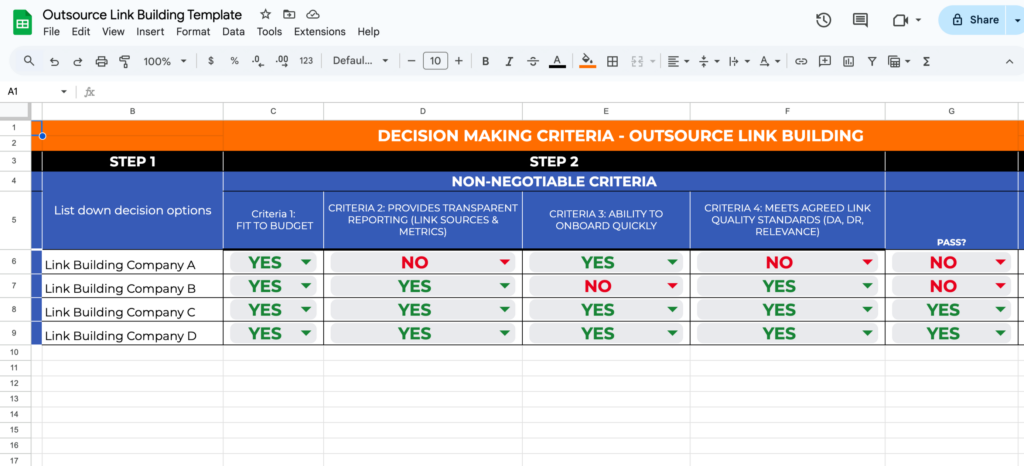
Here’s a step-by-step process for filling out the spreadsheet (which is also included in the “Instructions Tab”).
Step 1: Define Your Criteria
List down negotiable and non-negotiable criteria for your decision-making process in outsourcing link building. You can use the ECTEA model (Effectiveness, Cost, Time, Effort, Acceptance) to guide your criterion.
Step 2: Set Up the Decision-Making Analysis Sheet
In the Decision-Making tab, paste all your negotiable and non-negotiable criteria into separate columns.
Adjust columns and rows based on the number of criteria you have.
Step 3: Evaluate Link Building Agencies
Evaluate each link building agency based on your given criteria (both non-negotiable and negotiable).
For non-negotiable criteria, mark "Yes" or "No" for each link-building agency.
Proceed only with agencies that meet all non-negotiable criteria (i.e., all "Yes" responses).
Step 4: Rank Agencies Based on Negotiable Criteria
- For each negotiable criterion, mark "Yes" or "No" for every agency.
- Assign a score from 1 to 5 (1 = lowest, 5 = highest) based on how well the agency meets the negotiable criteria.
Step 5: Calculate Weighted Ratings & Make The Best Decision
- Compute the weighted rating by summing up the scores for each agency.
- Consider the link-building agency with the highest overall rating.
This decision-making analysis template allows you to make a rational, objective decision based on your criteria. You can do it yourself or best with the team of stakeholders and decision-makers in your team in outsourcing link building.
Evaluating Link Building ROI
Link-building ROI warrants a new guide, which I’ll share soon.
But in summary, if you want to see the value of your efforts, you should measure your link-building investment.
Here are a couple of things our clients looked at (and highly consider) with their investment in our link-building agency:
Page-Level and Category-Level Performance: Measure link impact on individual pages of your target links, in terms of increase in rankings, organic traffic, and page’s traffic value. It’s easy to track this using Ahrefs or other link intelligence tools.
ROI From Target Pages: If you select pages to build links to, you can track the return on investment you get from links that you outsource.
First, determine your conversion rate, average order value, and lifetime customer value for that specific product/service. Set this benchmark based on the current conversion for that page from organic search - you can see it on Google Analytics. These value items will be your baseline in checking if there’s ROI from links.
Share of Voice: Assess how much visibility your brand gains relative to competitors. SEMRush allows you to quickly see the share of voice—based on the competitors you input in the dashboard.
Types of Link Building Services
Agencies have different link-building models to choose from:
Managed Link Building Plans
Agencies handle everything from strategy to execution, involving link-building strategy, prospecting, outreach, and reporting. This is a done-for-you service that takes your hands off everything related to link building.
Pay-Per-Link Pricing:
This is arguably the best type of link-building service model. Given that you’ll only be paying for links you receive and have been reported by the agency, you only pay for actual results - not for monthly retainers with no guarantees of the number of links to be delivered.
At SharpRocket, we operate on this pay-per-link pricing model. We want to serve our clients at the highest level and earn everything they pay us.
If you need a few links to boost the rankings of your key pages or are looking for a reliable link-building partner to scale your link-building projects, contact us today for a discovery and strategy call.
Advanced Competitor Backlink Analysis For Mid-Weight SEOs [Template Included]
For years, competitor backlink analysis has been a universal process for any SEOs who are instantly looking for link opportunities.
The approach not only presents a quick analysis of your competitors’ existing links but could also uncover insights into their current strategy and help you generate ideas for your link building campaign.
The typical process goes like this:
- Use a backlink analysis tool such as Ahrefs, Majestic, or Moz.
- Review your competitors’ backlink profiles.
- Identify the types of links they’ve acquired.
- Start building links based on your findings.
While this provides a good benchmark, this type of analysis is not comprehensive enough to inform you of what’s happening in the industry from a link perspective and help you drive forward your next link building.
In this guide, I’ll show how we do advanced competitor backlink analysis, which includes:
- Selecting different types of competitors for backlink analysis (not just your direct competitors).
- Doing link gap analysis to answer the question, “how many backlinks do I need to rank?”
- Seeing patterns in linking pages and understanding why the site acquired the links.
- Replicating the exact link building strategy (or doing even way better) to leverage available link opportunities in specific markets.
Let’s get started.
What is competitor backlink analysis?
Competitor backlink analysis is the process of reverse engineering your competitors’ backlink profiles to see their existing backlinks, uncovering insights and strategies for your own link building campaign.
How to Perform Competitor Backlink Analysis?
There are many link intelligence tools available on the market. I use Ahrefs throughout this guide, given its huge link database and useful features for better analysis.
Step 1: Identify websites with which to reverse engineer.
Competitor link analysis starts by determining the domains/pages you want to assess.
I’ll give you the different types of websites or businesses on which to do competitor link analysis.
Direct Competitors
For example, if you’re selling bathtubs in London, you probably have a list of direct competitors in your space (as you may have done market research as you start your business operations).
If not, you can search for organic competitors ranking for the keyword you vet on. These are your direct competitors.
Direct ranking competitors are currently ranking for head terms you’re also competing with.
Ahrefs has a feature that shows you your direct competitors. You can find them by looking at “Organic Competitors” under “Organic Search.”
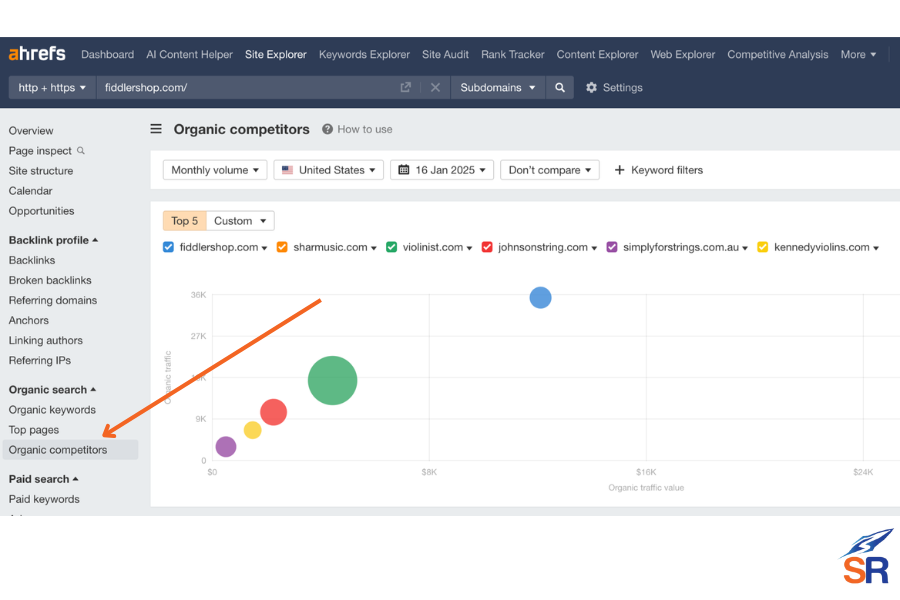
What it shows you depends on your input.
Using the “domain” and “subdomain” target modes will show you organic competitors that rank in the top 10 organic search results for the exact keywords from which your website gets the most traffic.
Using the “exact URL” target mode or “path” target mode shows you competing pages that rank in the top 100 organic search results for the same keywords that your target gets the most traffic from in the top 10 results.
For example, using Ahrefs’ Organic Competitors to find competitors of a potential client - JustBaths, it shows two types of direct competitors:
- A niche direct competitor - e.g. Omnitub, an online store selling only bathtubs
- A brand with a competing product category - e.g. Bathroom City with bathtubs as part of its product line/category (they’re selling other products besides bathtubs).
I could find link opportunities by reverse engineering both websites: Omnitub's exact URL/Path target mode and Bathroom City's Domain target mode.
Big Websites
Direct competitors are the tip of the iceberg for competitor backlink analysis. There are many other niche-related sites where you can find thousands of link opportunities.
For example, Wayfair UK is an online retailer that offers a wide selection of furniture, home decor, and household items. With DR73+, you can collect hundreds of link opportunities through backlink analysis.
If I were building links for this niche, I would start by assessing pages linked to the specific category page - Bathtubs. Then, once I exhaust the opportunities, I would look at sites linked to the entire domain (including links to other category pages).
The benefit of competitor backlink analysis for big websites is that it widens your link prospecting scope. This means that after looking for highly relevant link opportunities (in our example, you only want to find bathtub-specific publications/blogs), it only takes time before you exhaust all opportunities covering bathtub topics.
This is where you need to tap into 2nd to 4th degrees of backlink relevance, and it goes like this:
- 2nd degree of backlink relevance - websites that are not focused on your target content but have sections or categories strongly related to them. (e.g. home improvement, DIY, interior design, retailers with bathroom sections, etc..).
- 3rd degree of backlink relevance - websites that do not focus on your target keywords and have no categories about them but belong to the same general industry. (e.g. home and garden, architecture and design, real estate, sustainability, etc..)
- 4th degree of backlink relevance - websites that don’t belong in the same industry/topic niche but can publish articles related to its core content theme and your website’s. (e.g. health and wellness, parenting, travel, luxury lifestyle, fitness and recovery, etc..).
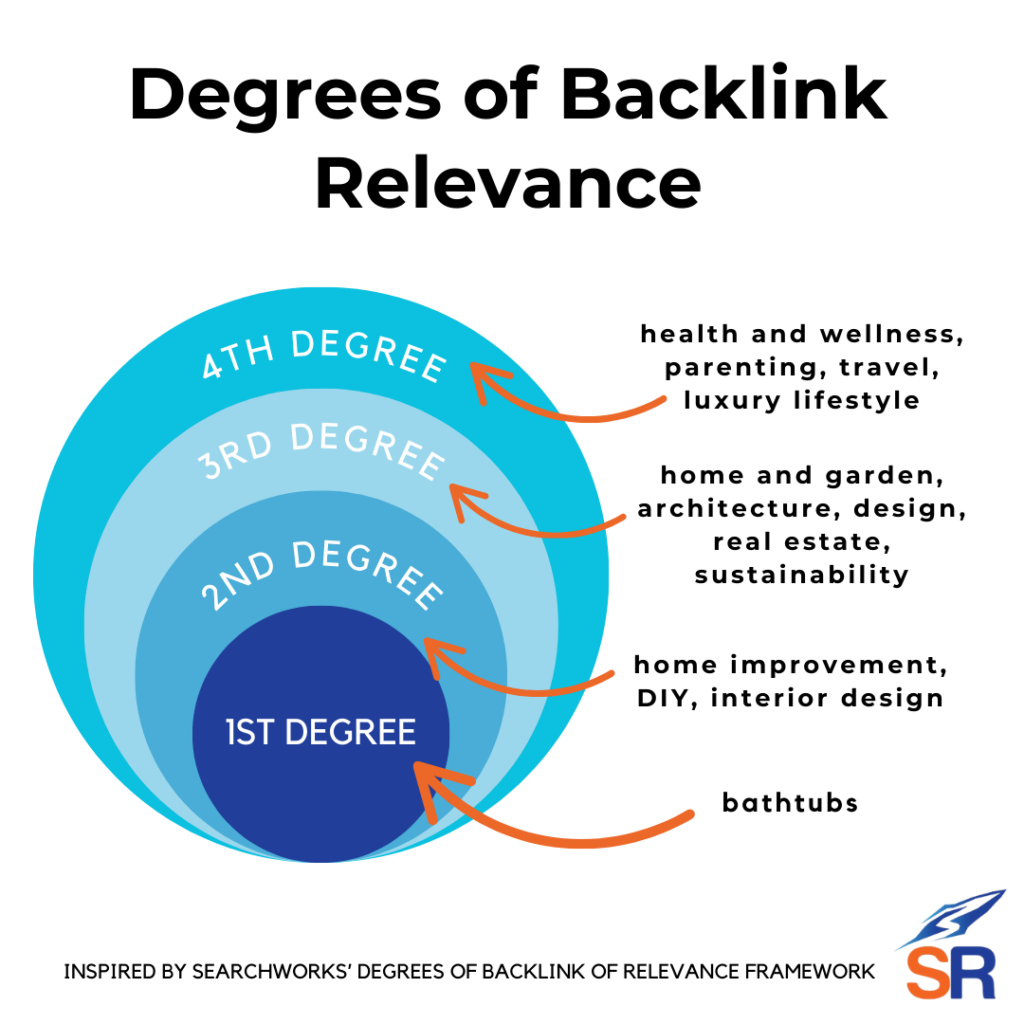
Conducting competitor backlink analysis for large websites allows you to tap into the second to fourth degrees of backlink relevance, expanding your list of potential link targets.
Local & Geographical Websites
For local SEO, the more localized your links, the more significant their impact on your domain authority and linking pages.
Look at local businesses within the geographical area, which may not necessarily be topically relevant but are within the local context.
For instance, if you’re doing SEO for a wedding business in Manchester, you should also be searching for other local businesses in the area:
- Hospitality Lifestyle
- Well-being Local Experience
- Tourism
- Home & Interior Design
- Professional Services
- High-End Retail & Artisanal Shops
Pro Tip: Check local directories like Yelp to see what types and industries of businesses are getting the majority of listings.
When you perform competitor backlink analysis for local businesses, you find specific linkable audiences with many opportunities for linking within the context. Since most are connected via associations and organizations, linking to other localized brands is highly possible - thus, providing you with higher chances of links.
Similar Content Competitors
For product-led and content-led link-building campaigns, one effective way to promote a content asset is to contact publishers who link to similar content. Given their familiarity with the content’s theme, there’s a likelihood of getting links from these content publishers.
For instance, if I published a sleeping guide for parents, I’ll check the ranking pages for the keyphrase “sleeping” for parents guide and do a competitor backlink analysis for these pages to see who linked to them.
Pro Tip: Go one step higher by looking at other content assets that are not directly focused on your content’s theme.
So in my earlier example, it could be any content piece about sleeping tips/guide: sleep science & research, healthy sleep habits & routines, work & productivity sleep optimization, fitness, recovery & sleep performance, travel & jet lag solutions, bedroom design & sleep environment, sleep tech & gadgets, etc..).
You may lack link opportunities when you over-narrow your competitor's backlink analysis. However, you can expand your applicable link prospects by examining other content’s themes.
Step 2. Get Backlink Data of Competitors
Plug each website into Ahrefs (or any link intelligence tool).
Navigate to the Backlinks report page.
Filter for “one link per domain, " then export the data as a CSV.
Step 3. Derive Insights and Strategy From Analysis
The next step is to analyze the backlink data and uncover insights and ideas for a link building strategy.
Initially, we start with a link gap analysis.
Link Gap Analysis
Link gap analysis (or “backlink gap analysis”) determines the difference between your competitors’ links and yours.
It answers the question, “how many backlinks do I need to rank?”.
Through link gap analysis, you’ll get an estimated number of links and how much effort you need to put into your link building campaign to rank within the top 3 spots for your target keyword.
To simplify things, I’ve created a free tool that allows you to instantly see the links needed to rank for your target keyword.
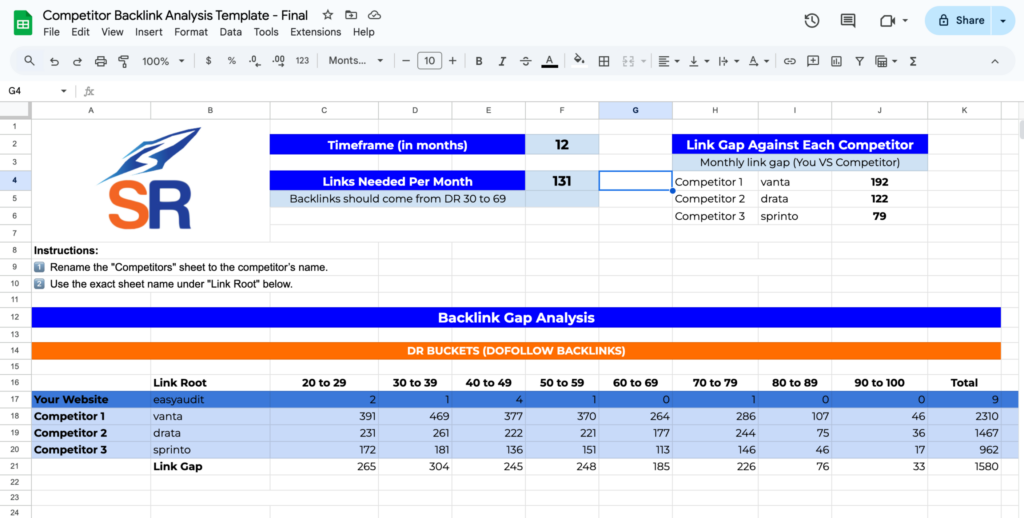
Once you have a copy of this template, import your site’s backlink data and competitors’ - as new sheets.
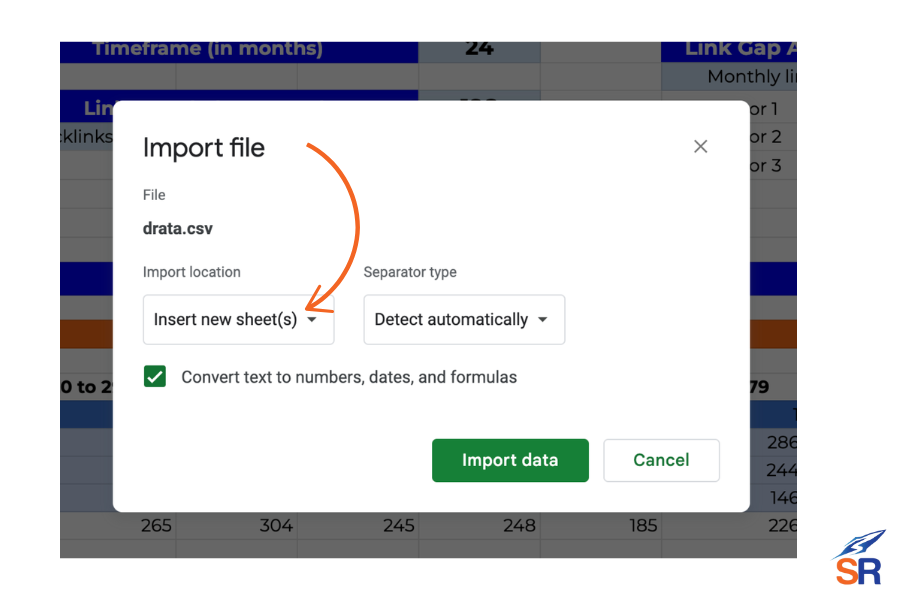
Rename the tab based on the name of the domain.
In the “Link Root” column, change it to the sheet tab name (your domain and your competitors). If sheet names are correct, it’ll only pull relevant data from other tabs.
Finally, it will show you important insights based on the gathered backlink information.
Here are a couple of items you should notice quickly:
- “Links needed per month” - shows how many links you need to build per month to catch up with the average monthly links of your competitors. Change the timeframe depending on how many months you want to conduct your link-building campaign (e.g. from 12 months to 6 months).
- “Link Gap Against Each Competitor” - gives you the link gap score between you and each individual competitor (based on their monthly links).
- Dofollow Backlinks (on DR Buckets) helps you quickly assess links your competitors acquired (per buckets of Ahrefs’ DR). It gives you an idea of what range of Ahrefs’ DR to focus on in your link building campaign (and not second-guess it when starting).
Knowing how many links to build every month challenges your SEO team to focus on a strategy to hit the link goal. While you can’t one hundred percent do it, it’s better to have it than to wonder what to achieve every single month.
Discover and Analyze Valuable Link Opportunities
One of my favorite tasks in competitor backlink analysis is scanning the lists of links to sites/competitors to see if I can find any interesting patterns, insights, or ideas.
The main point is that you should look for any type of page or link that has occurred on many of the backlink profiles you assess. This would uncover a strategy that, through proper execution, can help you land multiple links.
To make things easier, combine your competitors' backlink data (exclude yours).
You can combine a group of CSV files into one using the Terminal app on a Macbook or a tool you search online.
You may also write a prompt on ChatGPT and upload the CSV files.
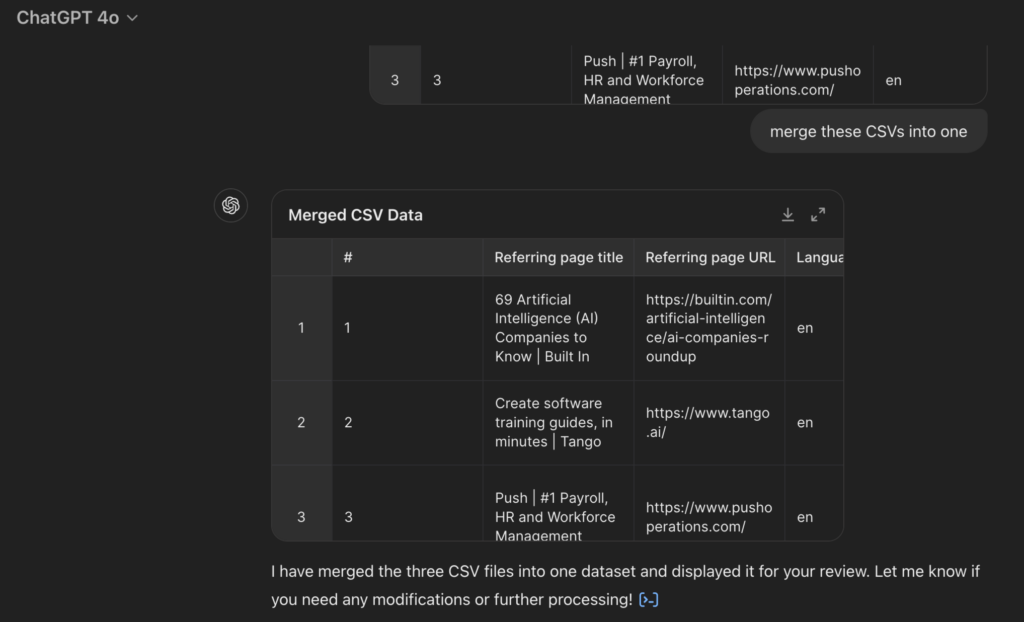
Once you have a merged file, remove the following columns that you may not need in your scanning process:
- Platform
- Referring domains
- Linked domains
- Content
- Nofollow
- UGC
- Sponsored
- Rendered
- Raw
- Drop reason
- Discovered status
- Lost
Then, delete these ones after filtering out the rows:
- Language - delete rows that aren’t “en” or “blank (unless you’re trying to scan non-English pages for an international link building campaign).
- Referring page HTTP code - delete rows with “404” or “403”.
- Lost status - remove rows that aren’t
Finally, you add a “Duplicates” column. For each referring page, we can see how many sites share the same referring page URL—this shows that it could be a resource/links page with links to all of your competitors.
For Duplicates column, add this formula: =COUNTIF(A:A,A2)
The next step is where you’ll spend most of your time, given that you’ll be scanning each page URL based on certain metrics.
To help you better understand how this works in real-life, I’ll show you different examples of competitor link analysis - for SaaS, eCommerce, and local businesses.
SaaS Example For Competitor Backlink Analysis
In this section, I’ll use the SaaS domains earlier as my example for competitors.
With their given backlink data, here are some interesting things I’ve found:
Backlink Analysis Technique #1: Duplicates + Filtering (Descending)
To see pages that are linked to 2 or more of your competitors.
The higher the number of duplicates, the more competitors’ links are included on the page. Without even browsing the page itself, a page with a higher external link count could mean that there are other sites it also linked out to (check column: External links).
Examples are roundup posts, links/resource pages, and group interviews.
In my SaaS example, we have some of the best roundup posts (Duplo Cloud, Ensuzo, Zluri, Scrut, Insight Assurance).
Direct and non-direct competitors and other publishers publish these roundup posts. This provides you with content insight: publish your own roundup post and make your software at the top of the list (as the best software for that category).
For backlinks, you may reach out to other publishers (of related roundup posts) and try to get included.
The more roundup posts that list you, the more visibility you gain, and the more likely that other publishers in the space will also include you in their roundups.
Backlink Analysis Technique #2: Homepage Links
By assessing homepage links, you’ll often find interesting link building tactics. One in particular, in our SaaS examples, is links from testimonials (homepage) and links from case studies. Examples are Vellum and Incident.
As soon as you gather patterns like this, you can also look at other similar link types. Search for page titles on your competitors’ backlink data using the keyphrase “case-studies”. It would reveal other case studies with Drata using other people’s products.
Link Building Tip: One good idea to test is to identify products and services your company has used, found satisfaction with, or has gotten results from. Offer your company a case study that the product/service can use for their middle-of-the-funnel content.
You’ll likely get a higher response rate, given that most SaaS are looking for case studies/results pages to showcase on their website.
eCommerce Example For Competitor Backlink Analysis
Let’s have an example in the eCommerce space.
We follow the same steps when performing a competitor backlink analysis. We chose a couple of competitors and exported their backlink data individually.
Backlink Analysis Technique #3: Filter By Ahrefs Domain Rating (Descending)
You'll see the most authoritative domains by filtering links from highest to lowest Ahrefs’ DR. These are gold nuggets for high-tier link-building opportunities.
For example, we’ve seen high-tier publications that one of the competitors has acquired using expert commentary tips, which helps increase their thought leadership in the industry.
Backlink Analysis Technique #4: Filter By External Links (<50) and Descending
By filtering links with less than 50 external links on the page and sorting them from highest to lowest, you’ll see resource pages, products/category list pages, and directories where your online store can be included.
You can quickly find it on the sheet by filtering words in page titles, such as “where to buy” or “store.”
Backlink Analysis Technique #5: With Left and Right Context, Filtered by DR25+ (Ascending)
Scanning backlink data allows you to spot specific types of backlinks that count.
For instance, by using information on the Left and Right context of the anchor text, you can quickly see editorial links on the list (editorial links are links where the publishers link out to other resources within the page's content).
These editorial links typically have surrounding words on the anchor text - within an article.
To spot them, filter out links with blank information on the left and right context. The remaining linking pages are most likely to be editorial links.
Local Business Example For Competitor Backlink Analysis
One last example is scanning for backlink data for local business competitors.
For instance, if I’m trying to do a competitor backlink analysis for pet clinics in London. I can start looking for other pet clinics in other regions, as they would open up new angles and insights for link building.
Below is a search result for the “pet clinic in Manchester” keyword.
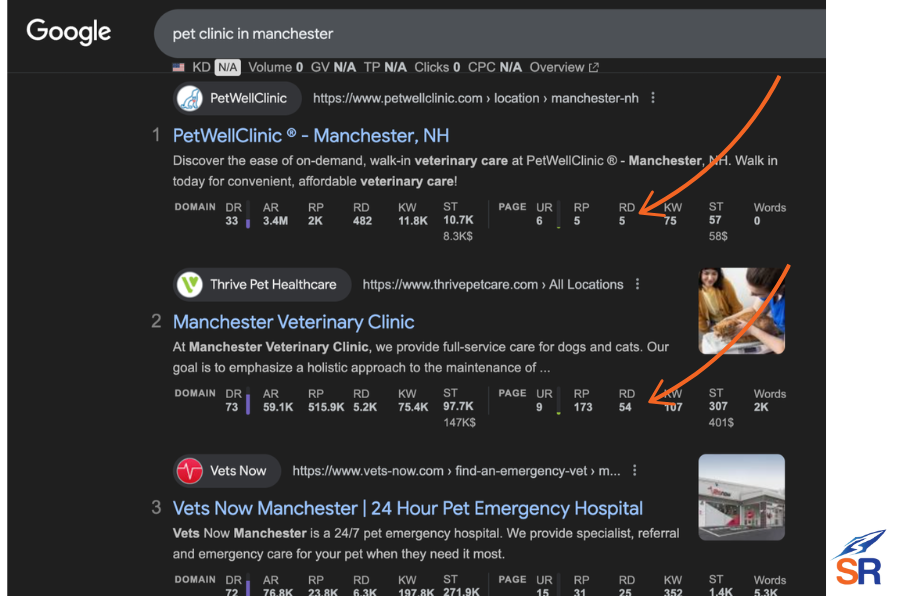
First, when scanning, I avoid directory listings and local citation sites that rank for the local keyword. I’ll try to find local business competitors.
Then, I enabled the metrics bar in Ahrefs’ Chrome extension to see each website's unique referring domains instantly (saving me from consuming much of Ahrefs credit).
I want to find domains with many referring domains (RD) because doing competitor backlink analysis for these sites is a goldmine for link opportunities.
Backlink Analysis Technique #6: “Find A” Directories and Citation Sites
In your scanning approach, you’ll undoubtedly come across a directory or listing site where you can submit your local business to be listed.
In general, most national business listings won’t positively impact your rankings. Most of these sites don’t have a strict or real vetting process for local businesses to be listed, so Google doesn’t value directory links.
However, there are a few niche directories where your local competitors are also listed. Check if these directories rank for a decent number of organic keywords using Ahrefs. If they do, spend minutes submitting your local business to them.
Also, find ones with a continuous vetting process in listings, like Pets Reunited - they remove fraudulent listings as soon as they receive scam reports and validate them.
Although it doesn’t carry as much weight as other link types, such as editorial and digital PR links, finding directories with good search traffic could help diversify your backlink profile.
Backlink Analysis Technique #7: Local Organization Finds
Other local links are local organizations, partnerships, and associations where your local business can be listed. Search them quickly on your backlink data sheet using “organization”.
You Don’t Have To Reinvent The Wheel
Regarding competitor backlink analysis, there’s no need to reinvent the wheel. Instead, analyze backlink profiles from similar businesses in highly competitive markets. Identify their strongest link-building strategies, extract the most effective approaches, and adapt them to your local landscape.
By continuously refining and applying these insights, you can build a robust backlink strategy that keeps you ahead of the competition.
